Complete List as on ADS arXiv
Cloud property trends in hot and ultra-hot giant gas planets (WASP-43b, WASP-103b, WASP-121b, HAT-P-7b, and WASP-18b)
Ch. Helling, D. Lewis, D. Samra, L. Carone, V. Graham, O. Herbort, K.L. Chubb, M. Min, R. Waters, V. Parmentier, N. Mayne
Astronomy & Astrophysics, 649, 44, 2021
Ultra-hot Jupiters are the hottest exoplanets that have been discovered so far. Observations begin to provide insight into the composition of their extended atmospheres and their chemical day/night asymmetries. Both are strongly affected by cloud formation.
We explore trends in cloud properties for a sample of five giant gas planets: the hot gas giant WASP-43b and the four ultra-hot Jupiters (UHJs) WASP-18b, HAT-P-7b, WASP-103b, and WASP-121b. This provides a reference frame for cloud properties for the JWST targets WASP-43b and WASP-121b. We further explore chemically inert tracers to observe geometrical asymmetries of UHJs and if the location of the inner boundary of a 3D global circulation model (3D GCM) matters for the clouds that form.
A homogeneous set of 3D GCM results was used as input for a kinetic cloud formation code to evaluate the cloud opacity and gas parameters such as C/O, mean molecular weight, and degree of ionisation. We cast our results in terms of integrated quantities to enable a global comparison between the sample planets.
The large day/night temperature differences of UHJs cause the following chemical asymmetries: cloud-free days but cloudy nights, atomic versus molecular gases and their different mean molecular weights, deep thermal ionospheres versus low-ionised atmospheres, and undepleted versus enhanced C/O. WASP-18b, as the heaviest planet in the sample, has the lowest global C/O.
The global climate may be considered as similar amongst UHJs, but different to that of hot gas giants. The local weather, however, is individual for each planet since the local thermodynamic conditions, and hence the local cloud and gas properties, differ. The morning and the evening terminator of UHJs will carry signatures of their strong chemical asymmetry such that ingress and egress asymmetries can be expected. An increased C/O ratio is a clear sign of cloud formation, making cloud modelling a necessity when utilising C/O (or other mineral ratios) as a tracer for planet formation. The changing geometrical extension of the atmosphere from the day to the nightside may be probed through chemically inert species such as helium. Ultra-hot Jupiters are likely to develop deep atmospheric ionospheres which may impact the atmosphere dynamics through magneto-hydrodynamic processes.
MOVES IV. Modelling the influence of stellar XUV-flux, cosmic rays, and stellar energetic particles on the atmospheric composition of the hot Jupiter HD 189733b
P. Barth, Ch. Helling, E.E. Stüeken, V. Bourrier, N. Mayne, P.B. Rimmer, M. Jardine, A.A. Vidotto, P.J. Wheatley, R. Fares
Monthly Notices of the Royal Astronomical Society, 502, 6201-6215, 2021
Hot Jupiters provide valuable natural laboratories for studying potential contributions of high-energy radiation to pre-biotic synthesis in the atmospheres of exoplanets. In this fourth paper of the Multiwavelength Observations of an eVaporating Exoplanet and its Star (MOVES) programme, we study the effect of different types of high-energy radiation on the production of organic and pre-biotic molecules in the atmosphere of the hot Jupiter HD 189733b. Our model combines X-ray and UV observations from the MOVES programme and 3D climate simulations from the 3D Met Office Unified Model to simulate the atmospheric composition and kinetic chemistry with the STAND2019 network. Also, the effects of galactic cosmic rays and stellar energetic particles are included. We find that the differences in the radiation field between the irradiated dayside and the shadowed nightside lead to stronger changes in the chemical abundances than the variability of the host star’s XUV emission. We identify ammonium (NH4+) and oxonium (H3O+) as fingerprint ions for the ionization of the atmosphere by both galactic cosmic rays and stellar particles. All considered types of high-energy radiation have an enhancing effect on the abundance of key organic molecules such as hydrogen cyanide (HCN), formaldehyde (CH2O), and ethylene (C2H4). The latter two are intermediates in the production pathway of the amino acid glycine (C2H5NO2) and abundant enough to be potentially detectable by JWST.
Understanding the atmospheric properties and chemical composition of the ultra-hot Jupiter HAT-P-7b. III. Changing ionisation and the emergence of an ionosphere
Ch. Helling, M. Worters, D. Samra, K. Molaverdikhani, N. Iro
Astronomy & Astrophysics, 648, 80, 2021
Ultra-hot Jupiters are the hottest exoplanets that have been discovered so far. They present a unique possibility to explore hot and cold chemistry on one object. The tidally locked ultra-hot Jupiter HAT-P-7b has a day-to-night temperature difference of ≃2500 K, confining cloud formation to the nightside and efficient ionisation to the dayside. Both have distinct observational signatures.
We analyse plasma and magnetic processes in the atmosphere of the ultra-hot Jupiter HAT-P-7b to investigate the formation of an ionosphere and the possibility of magnetically coupling the atmospheric gas as the base for an extended exosphere. We show which ions and atoms may be used as spectral tracers, and if and where conditions for lightning may occur within the clouds of HAT-P-7b.
We used 3D modelling results as input for a kinetic cloud formation code and evaluated characteristic plasma and magnetic coupling parameters. A local thermodynamical equilibrium radiative transfer was solved for the ionised gas phase. This study is confined to thermal ionisation only.
The ionisation throughout HAT-P-7b’s atmosphere varies drastically between day- and nightside. The dayside has high levels of thermal ionisation and long-range electromagnetic interactions dominate over kinetic electron-neutral interactions, suggesting a day-night difference in magnetic coupling. K+, Na+, Li+, Ca+, and Al+ are more abundant than their atomic counterparts on the dayside. The minimum magnetic flux density for electrons for magnetic coupling is B < 0.5 G for all regions of HAT-P-7b’s atmosphere.
HAT-P-7b’s dayside has an asymmetric ionosphere that extends deep into the atmosphere, the nightside has no thermally driven ionosphere. A corresponding asymmetry is imprinted in the ion and neutral composition at the terminators. The ionosphere on HAT-P-7b may be directly traced by the Ca+ H&K lines if the local temperature is ≥5000 K. The whole atmosphere may couple to a global, large-scale magnetic field, and lightning may occur on the nightside.
Clouds in Exoplanetary Atmospheres
Christiane Helling
book chapter in “ExoFrontiers: Big questions in exoplanetary science”, Ed. N Madhusudhan (Bristol: IOP Publishing Ltd) AAS-IOP ebooks
Today, we know ~4330 exoplanets orbiting their host stars in ~3200 planetary systems. The diversity of these exoplanets is large, and none of the known exoplanets is a twin to any of the solar system planets, nor is any of the known extrasolar planetary systems a twin of the solar system. Such diversity on many scales and structural levels requires fundamental theoretical approaches. Large efforts are underway to develop individual aspects of exoplanet sciences, like exoplanet atmospheres, cloud formation, disk chemistry, planet system dynamics, mantle convection, mass loss of planetary atmospheres. The following challenges need to be addressed in tandem with observational efforts. They provide the opportunity to progress our understanding of exoplanets and their atmospheres by exploring our models as virtual laboratories to fill gaps in observational data from different instruments and missions, and taken at different instances of times: Challenge a) Building complex models based on theoretical rigour that aim to understand the interactions of atmospheric processes, to treat cloud formation and its feedback onto the gas-phase chemistry and the energy budget of the planetary atmosphere moving away from solar-system inspired parameterisations. Challenge b) Enabling cloud modelling based on fundamental physio-chemical insights in order to be applicable to the large and unexplored chemical, radiative and thermodynamical parameter range of exoplanets in the universe. Challenge b) will be explored in this chapter of the book ExoFrontiers.
Coexistence of CH4, CO2 and H2O in exoplanet atmospheres
P. Woitke, O. Herbort, Ch. Helling, E.Stüeken, M. Dominik, P. Barth, D. Samra
Astronomy & Astrophysics, 646, 43, 2021
We propose a classification of exoplanet atmospheres based on their H, C, O, and N element abundances below about 600 K. Chemical equilibrium models were run for all combinations of H, C, O, and N abundances, and three types of solutions were found, which are robust against variations of temperature, pressure, and nitrogen abundance. Type A atmospheres contain H2O, CH4, NH3, and either H2 or N2, but only traces of CO2 and O2. Type B atmospheres contain O2, H2O, CO2, and N2, but only traces of CH4, NH3, and H2. Type C atmospheres contain H2O, CO2, CH4, and N2, but only traces of NH3, H2, and O2. Other molecules are only present in ppb or ppm concentrations in chemical equilibrium, depending on temperature. Type C atmospheres are not found in the Solar System, where atmospheres are generally cold enough for water to condense, but exoplanets may well host such atmospheres. Our models show that graphite (soot) clouds can occur in type C atmospheres in addition to water clouds, which can occur in all types of atmospheres. Full-equilibrium condensation models show that the outgassing from warm rock can naturally provide type C atmospheres. We conclude that type C atmospheres, if they exist, would lead to false positive detections of biosignatures in exoplanets when considering the coexistence of CH4 and CO2, and suggest other, more robust non-equilibrium markers.
The ARCiS framework for exoplanet atmospheres. Modelling philosophy and retrieval
M. Min, C.W. Ormel, K. Chubb, Ch. Helling, Y. Kawashima
Astronomy & Astrophysics, 642, 28, 2020
We present ARCiS, a novel code for the analysis of exoplanet transmission and emission spectra. The aim of the modelling framework is to provide a tool able to link observations to physical models of exoplanet atmospheres.
The modelling philosophy chosen in this paper is to use physical and chemical models to constrain certain parameters while leaving certain parts of the model, where our physical understanding remains limited, free to vary. This approach, in between full physical modelling and full parameterisation, allows us to use the processes we understand well and parameterise those less understood. We implemented a Bayesian retrieval framework and applied it to the transit spectra of a set of ten hot Jupiters. The code contains chemistry and cloud formation and has the option for self-consistent temperature structure computations.
The code presented is fast and flexible enough to be used for retrieval and for target list simulations for JWST or the ESA Ariel missions for example. We present results for the retrieval of elemental abundance ratios using the physical retrieval framework and compare this to results obtained using a parameterised retrieval setup.
We conclude that for most of the targets considered, their elemental abundance ratios cannot be reliably constrained based on the current dataset. We find no significant correlations between different physical parameters. We confirm that planets in our sample with a strong slope in the optical transmission spectrum are those for which we find cloud formation to be most active. Finally, we conclude that with ARCiS we have a computationally efficient tool to analyse exoplanet observations in the context of physical and chemical models.
Mineral cloud and hydrocarbon haze particles in the atmosphere of the hot Jupiter JWST target WASP-43b
Ch. Helling, Y. Kawashima, V. Graham, D. Samra, K.L. Chubb, M. Min, M.; L.B.F.M. Waters, V. Parmentier
Astronomy & Astrophysics, 641, 178, 2020
Having a short orbital period and being tidally locked makes WASP-43b an ideal candidate for the James Webb Space Telescope (JWST) phase curve measurements. Phase curve observations of an entire orbit will enable the mapping of the atmospheric structure across the planet, with different wavelengths of observation allowing different atmospheric depths to be seen.
We provide insight into the details of the clouds that may form on WASP-43b and their impact on the remaining gas phase, in order to prepare the forthcoming interpretation of the JWST and follow-up data.
We follow a hierarchical modelling strategy. We utilise 3D GCM results as input for a kinetic, non-equilibrium model for mineral cloud particles and for a kinetic model to study a photochemically-driven hydrocarbon haze component.
Mineral condensation seeds form throughout the atmosphere of WASP-43b. This is in stark contrast to the ultra-hot Jupiters, such as WASP-18b and HAT-P-7b. The dayside is not cloud free but it is loaded with few yet large mineral cloud particles in addition to hydrocarbon haze particles of a comparable abundance. Photochemically driven hydrocarbon haze appears on the dayside, but it does not contribute to the cloud formation on the nightside. The geometrical cloud extension differs across the globe due to the changing thermodynamic conditions. Day and night differ by 6000 km in pressure scale height. As reported for other planets, the C/O is not constant throughout the atmosphere and varies between 0.74 and 0.3. The mean molecular weight is approximately constant in a H2-dominated WASP-43b atmosphere because of the moderate day/night-temperature differences compared to the super-hot Jupiters.
WASP-43b is expected to be fully covered in clouds which are not homogeneously distributed throughout the atmosphere. The dayside and the terminator clouds are a combination of mineral particles of locally varying size and composition as well as of hydrocarbon hazes. The optical depth of hydrocarbon hazes is considerably lower than that of mineral cloud particles such that a wavelength-dependent radius measurement of WASP-43b would be determined by the mineral cloud particles but not by hazes.
Large-scale changes of the cloud coverage in the ∊ Indi Ba and Bb system
J.A. Hitchcock, Ch. Helling, A. Scholz, G. Hodosan, M. Dominik, M. Hundertmark, U.G. Jørgensen, P. Longa-Peña, S. Sajadian, J. Skottfelt, C. Snodgrass, V. Bozza, M.J. Burgdorf, J. Campbell-White, R. Figuera Jaimes, Y.I. Fujii, L.K. Haikala, T. Henning, T.C. Hinse, S. Lowry, L. Mancini, S. Rahvar, M. Rabus, J. Southworth, C. von Essen, Mindstep Collaboration
Monthly Notices of the Royal Astronomical Society, 495, 3881-3899, 2020
We present the results of 14 nights of I-band photometric monitoring of the nearby brown dwarf binary, ∊ Indi Ba and Bb. Observations were acquired over 2 months, with a total of close to 42 h of coverage at a typically high cadence of 1.4 min. At a separation of just 0.7 arcsec, we do not resolve the individual components, and so effectively treat the binary as if it were a single object. However, ∊ Indi Ba (spectral type T1) is the brightest known T-type brown dwarf, and is expected to dominate the photometric signal. We typically find no strong variability associated with the target during each individual night of observing, but see significant changes in mean brightness – by as much as 0.10 mag – over the 2 months of the campaign. This strong variation is apparent on a time-scale of at least 2 d. We detect no clear periodic signature, which suggests that we may be observing the T1 brown dwarf almost pole-on, and the days-long variability in mean brightness is caused by changes in the large-scale structure of the cloud coverage. Dynamic clouds will very likely produce lightning, and complementary high-cadence V-band and H α images were acquired to search for the emission signatures associated with stochastic ‘strikes’. We report no positive detections for the target in either of these passbands.
Mineral snowflakes on exoplanets and brown dwarfs. Effects of micro-porosity, size distributions, and particle shape
D. Samra, Ch. Helling, M. Min
Astronomy & Astrophysics, 639, 107, 2020
Exoplanet atmosphere characterisation has become an important tool in understanding exoplanet formation, evolution, and it also is a window into potential habitability. However, clouds remain a key challenge for characterisation: upcoming space telescopes (e.g. the James Webb Space Telescope, JWST, and the Atmospheric Remote-sensing Infrared Exoplanet Large-survey) and ground-based high-resolution spectrographs (e.g. the next-generation CRyogenic high-resolution InfraRed Echelle Spectrograph) will produce data requiring detailed understanding of cloud formation and cloud effects for a variety of exoplanets and brown dwarfs.
We aim to understand how the micro-porosity of cloud particles affects the cloud structure, particle size, and material composition on exoplanets and brown dwarfs. We further examine the spectroscopic effects of micro-porous particles, the particle size distribution, and non-spherical cloud particles.
We expanded our kinetic non-equilibrium cloud formation model to study the effect of micro-porosity on the cloud structure using prescribed 1D (Tgas-pgas) profiles from the DRIFT-PHOENIX model atmosphere grid. We applied the effective medium theory and the Mie theory to model the spectroscopic properties of cloud particles with micro-porosity and a derived particle size distribution. In addition, we used a statistical distribution of hollow spheres to represent the effects of non-spherical cloud particles.
Highly micro-porous cloud particles (90% vacuum) have a larger surface area, enabling efficient bulk growth higher in the atmosphere than for compact particles. Increases in single scattering albedo and cross-sectional area for these mineral snowflakes cause the cloud deck to become optically thin only at a wavelength of ~100 μm instead of at the ~20 μm for compact cloud particles. A significant enhancement in albedo is also seen when cloud particles occur with a locally changing Gaussian size distribution. Non-spherical particles increase the opacity of silicate spectral features, which further increases the wavelength at which the clouds become optically thin.
Retrievals of cloud properties, particularly particle size and mass of clouds, are biased by the assumption of compact spherical particles. The JWST mid-infrared instrument will be sensitive to signatures of micro-porous and non-spherical cloud particles based on the wavelength at which clouds are optically thin. Details of spectral features are also dependent on particle shape, and greater care must be taken in modelling clouds as observational data improves.
Aluminium oxide in the atmosphere of hot Jupiter WASP-43b
K.L. Chubb, M. Min, Y. Kawashima, Ch. Helling, I. Waldmann
Astronomy & Astrophysics, 639, 3, 2020
We have conducted a re-analysis of publicly available Hubble Space Telescope Wide Field Camera 3 (HST WFC3) transmission data for the hot-Jupiter exoplanet WASP-43b, using the Bayesian retrieval package Tau-REx. We report evidence of AlO in transmission to a high level of statistical significance (>5σ in comparison to a flat model, and 3.4σ in comparison to a model with H2O only). We find no evidence of the presence of CO, CO2, or CH4 based on the available HST WFC3 data or on Spitzer IRAC data. We demonstrate that AlO is the molecule that fits the data to the highest level of confidence out of all molecules for which high-temperature opacity data currently exists in the infrared region covered by the HST WFC3 instrument, and that the subsequent inclusion of Spitzer IRAC data points in our retrieval further supports the presence of AlO. H2O is the only other molecule we find to be statistically significant in this region. AlO is not expected from the equilibrium chemistry at the temperatures and pressures of the atmospheric layer that is being probed by the observed data. Its presence therefore implies direct evidence of some disequilibrium processes with links to atmospheric dynamics. Implications for future study using instruments such as the James Webb Space Telescope are discussed, along with future opacity needs. Comparisons are made with previous studies into WASP-43b.
The atmospheres of rocky exoplanets. I. Outgassing of common rock and the stability of liquid water
O. Herbort, P. Woitke, Ch. Helling, A. Zerkle
Astronomy & Astrophysics, 636, 71, 2020
Little is known about the interaction between atmospheres and crusts of exoplanets so far, but future space missions and ground-based instruments are expected to detect molecular features in the spectra of hot rocky exoplanets.
We aim to understand the composition of the gas in an exoplanet atmosphere which is in equilibrium with a planetary crust.
The molecular composition of the gas above a surface made of a mixture of solid and liquid materials was determined by assuming phase equilibrium for given pressure, temperature, and element abundances. We study total element abundances that represent different parts of the Earth’s crust (continental crust, bulk silicate Earth, mid oceanic ridge basalt), CI chondrites and abundances measured in polluted white dwarfs.
For temperatures between ~600 and ~3500 K, the near-crust atmospheres of all considered total element abundances are mainly composed of H2O, CO2, and SO2 and in some cases of O2 and H2. For temperatures ≲500 K, only N2-rich or CH4-rich atmospheres remain. For ≳3500 K, the atmospheric gas is mainly composed of atoms (O, Na, Mg, and Fe), metal oxides (SiO, NaO, MgO, CaO, AlO, and FeO), and some metal hydroxides (KOH and NaOH). The inclusion of phyllosilicates as potential condensed species is crucial for lower temperatures, as they can remove water from the gas phase below about 700 K and inhibit the presence of liquid water.
Measurements of the atmospheric composition could, in principle, characterise the rock composition of exoplanet crusts. H2O, O2 and CH4 are natural products from the outgassing of different kinds of rocks that had time to equilibrate. These are discussed as biomarkers, but they do emerge naturally as a result of the thermodynamic interaction between the crust and atmosphere. Only the simultaneous detection of all three molecules might be a sufficient biosignature, as it is inconsistent with chemical equilibrium.
MOVES III. Simultaneous X-ray and ultraviolet observations unveiling the variable environment of the hot Jupiter HD 189733b
V. Bourrier, P.J. Wheatley, A. Lecavelier des Etangs, G. King, T. Louden, D. Ehrenreich, R. Fares, Ch. Helling, J. Llama, M.M. Jardine, A.A. Vidotto
Monthly Notices of the Royal Astronomical Society, 493, 559-579, 2020
In this third paper of the MOVES (Multiwavelength Observations of an eVaporating Exoplanet and its Star) programme, we combine Hubble Space Telescope far-ultraviolet (FUV) observations with XMM-Newton/Swift X-ray observations to measure the emission of HD 189733 in various FUV lines, and its soft X-ray spectrum. Based on these measurements we characterize the interstellar medium towards HD 189733 and derive semisynthetic XUV spectra of the star, which are used to study the evolution of its high-energy emission at five different epochs. Two flares from HD 189733 are observed, but we propose that the long-term variations in its spectral energy distribution have the most important consequences for the environment of HD 189733b. Reduced coronal and wind activity could favour the formation of a dense population of Si2+ atoms in a bow-shock ahead of the planet, responsible for pre- and in-transit absorption measured in the first two epochs. In-transit absorption signatures are detected in the Lyman α line in the second, third, and fifth epochs, which could arise from the extended planetary thermosphere and a tail of stellar wind protons neutralized via charge-exchange with the planetary exosphere. We propose that increases in the X-ray irradiation of the planet, and decreases in its EUV irradiation causing lower photoionization rates of neutral hydrogen, favour the detection of these signatures by sustaining larger densities of H0 atoms in the upper atmosphere and boosting charge-exchanges with the stellar wind. Deeper and broader absorption signatures in the last epoch suggest that the planet entered a different evaporation regime, providing clues as to the link between stellar activity and the structure of the planetary environment.
Dust in brown dwarfs and extra-solar planets. VII. Cloud formation in diffusive atmospheres
Peter Woitke, Christiane Helling, Ophelia Gunn
Astronomy & Astrophysics, Volume 634, 23, 2020
The precipitation of cloud particles in brown dwarf and exoplanet atmospheres establishes an ongoing downward flux of condensable elements. To understand the efficiency of cloud formation, it is therefore crucial to identify and quantify the replenishment mechanism that is able to compensate for these local losses of condensable elements in the upper atmosphere, and to keep the extrasolar weather cycle running. In this paper, we introduce a new cloud formation model by combining the cloud particle moment method we described previously with a diffusive mixing approach, taking into account turbulent mixing and gas-kinetic diffusion for both gas and cloud particles. The equations are of diffusion-reaction type and are solved time-dependently for a prescribed 1D atmospheric structure, until the model has relaxed toward a time-independent solution. In comparison to our previous models, the new hot-Jupiter model results (Teff ≈ 2000 K, log g = 3) show fewer but larger cloud particles that are more concentrated towards the cloud base. The abundances of condensable elements in the gas phase are featured by a steep decline above the cloud base, followed by a shallower, monotonous decrease towards a plateau, the level of which depends on temperature. The chemical composition of the cloud particles also differs significantly from our previous models. Through the condensation of specific condensates such as Mg2SiO4[s] in deeper layers, certain elements, such as Mg, are almost entirely removed early from the gas phase. This leads to unusual (and non-solar) element ratios in higher atmospheric layers, which then favours the formation of SiO[s] and SiO2[s], for example, rather than MgSiO3[s]. These condensates are not expected in phase-equilibrium models that start from solar abundances. Above the main silicate cloud layer, which is enriched with iron and metal oxides, we find a second cloud layer made of Na2S[s] particles in cooler models (Teff ⪅ 1400 K).
Understanding the atmospheric properties and chemical composition of the ultra-hot Jupiter HAT-P-7b. II. Mapping the effects of gas kinetics
K. Molaverdikhani, Ch. Helling, B.W.P. Lew, R.J. MacDonald, D. Samra, N. Iro, P. Woitke, V. Parmentier
Astronomy & Astrophysics, Volume 635, 31, 2020
The atmospheres of ultra-hot Jupiters (UHJs) are commonly considered to be at thermochemical equilibrium. We aim to provide disequilibrium chemistry maps for a global understanding of the chemistry in the atmosphere of HAT-P-7b and assess the importance of disequilibrium chemistry on UHJs.
We applied a hierarchical modeling approach using 97 1D atmospheric profiles from a 3D general circulation model of HAT-P-7b. For each atmospheric 1D profile, we evaluated our kinetic cloud formation model consistently with the local gas-phase composition in chemical equilibrium. This served as input to study the quenching of dominating CHNO-binding molecules. We evaluated quenching results from a zeroth-order approximation in comparison to a kinetic gas-phase approach.
We find that the zeroth-order approach of estimating quenching points agrees well with the full gas-kinetic modeling results. However, it underestimates the quenching levels by about one order of magnitude at high temperatures. Chemical disequilibrium has the greatest effect on the nightside and morning abundance of species such as H, H2O, CH4, CO2, HCN, and all CnHm molecules; heavier CnHm molecules are more affected by disequilibrium processes. The CO abundance, however, is affected only marginally. While dayside abundances also notably change, those around the evening terminator of HAT-P-7b are the least affected by disequilibrium processes. The latter finding may partially explain the consistency of observed transmission spectra of UHJs with atmospheres in thermochemical equilibrium. Photochemistry only negligibly affects molecular abundances and quenching levels.
In general, the quenching points of the atmosphere of HAT-P-7b are at much lower pressures than in the cooler hot-jupiters. We propose several avenues to determining the effect of disequilibrium processes on UHJs that are in general based on abundance and opacity measurements at different local times. It remains a challenge to completely disentangle this from the chemical effects of clouds and that of a primordial nonsolar abundance.
Understanding the atmospheric properties and chemical composition of the ultra-hot Jupiter HAT-P-7b. I. Cloud and chemistry mapping
Ch. Helling, N. Iro, L. Corrales, D. Samra, K. Ohno, M.K. Alam, M. Steinrueck, B. Lew, K. Molaverdikhani, R.J. MacDonald, O. Herbort, P. Woitke, V. Parmentier
Astronomy & Astrophysics, Volume 631, 79, 2019
Of the presently known ≈3900 exoplanets, sparse spectral observations are available for ≈100. Ultra-hot Jupiters have recently attracted interest from observers and theoreticians alike, as they provide observationally accessible test cases. Confronting detailed theoretical models with observations is of preeminent importance in preparation for upcoming space-based telescopes.
We aim to study cloud formation on the ultra-hot Jupiter HAT-P-7b, the resulting composition of the local gas phase, and how their global changes affect wavelength-dependent observations utilised to derive fundamental properties of the planet.
We apply a hierarchical modelling approach as a virtual laboratory to study cloud formation and gas-phase chemistry. We utilise 97 vertical 1D profiles of a 3D GCM for HAT-P-7b to evaluate our kinetic cloud formation model consistently with the local equilibrium gas-phase composition. We use maps and slice views to provide a global understanding of the cloud and gas chemistry.
The day/night temperature difference on HAT-P-7b (ΔT ≈ 2500 K) causes clouds to form on the nightside (dominated by H2/He) while the dayside (dominated by H/He) retains cloud-free equatorial regions. The cloud particles vary in composition and size throughout the vertical extension of the cloud, but also globally. TiO2[s]/Al2O3[s]/CaTiO3[s]-particles of cm-sized radii occur in the higher dayside-latitudes, resulting in a dayside dominated by gas-phase opacity. The opacity on the nightside, however, is dominated by 0.01…0.1μm particles made of a material mix dominated by silicates. The gas pressure at which the atmosphere becomes optically thick is ~10−4 bar in cloudy regions, and ~0.1 bar in cloud-free regions.
HAT-P-7b features strong morning/evening terminator asymmetries, providing an example of patchy clouds and azimuthally-inhomogeneous chemistry. Variable terminator properties may be accessible by ingress/egress transmission photometry (e.g., CHEOPS and PLATO) or spectroscopy. The large temperature differences of ≈2500 K result in an increasing geometrical extension from the night- to the dayside. The H2O abundance at the terminator changes by <1 dex with altitude and ≲0.3 dex (a factor of 2) across the terminator for a given pressure, indicating that H2O abundances derived from transmission spectra can be representative of the well-mixed metallicity at P ≳ 10 bar. We suggest the atmospheric C/O as an important tool to trace the presence and location of clouds in exoplanet atmospheres. The atmospheric C/O can be sub- and supersolar due to cloud formation. Phase curve variability of HAT-P-7b is unlikely to be caused by dayside clouds.
Lightning in other planets
Christiane Helling
Journal of Physics: Conference Series, Volume 1322, Issue 1, 012028 (2019)
More than 4000 planets are known that orbit stars other than our Sun. Many harbor a dynamic atmosphere that is cold enough that cloud particles can form in abundance. The diversity of exoplanets leads to differences in cloud coverage depending on global system parameters. Some planets will be fully covered in clouds, some have clouds on the nightside but are largely cloud-free on the dayside. These cloud particles can easily be charged and lightning discharges will occur in cloudy, dynamic exoplanet atmosphere. Lightning supports a Global Electric Circuit (GCE) on Earth and we argue that exoplanet may develop a GCE in particular if parts of the exoplanet atmospheres can remain cloud free.
MOVES II. Tuning in to the radio environment of HD189733b
R.D. Kavanagh, A.A. Vidotto, D. Ó. Fionnagáin, V. Bourrier, R. Fares, M. Jardine, Ch. Helling, C. Moutou, J. Llama, P.J. Wheatley
Monthly Notices of the Royal Astronomical Society, 485, 4529-4538, 2019
We present stellar wind modelling of the hot Jupiter host HD189733, and predict radio emission from the stellar wind and the planet, the latter arising from the interaction of the stellar wind with the planetary magnetosphere. Our stellar wind models incorporate surface stellar magnetic field maps at the epochs 2013 June/July, 2014 September, and 2015 July as boundary conditions. We find that the mass-loss rate, angular momentum loss rate, and open magnetic flux of HD189733 vary by 9 per cent, 40 per cent, and 19 per cent over these three epochs. Solving the equations of radiative transfer, we find that from 10 MHz-100 GHz the stellar wind emits fluxes in the range of 10-3-5 μJy, and becomes optically thin above 10 GHz. Our planetary radio emission model uses the radiometric Bode’s law, and neglects the presence of a planetary atmosphere. For assumed planetary magnetic fields of 1-10 G, we estimate that the planet emits at frequencies of 2-25 MHz, with peak flux densities of 102 mJy. We find that the planet orbits through regions of the stellar wind that are optically thick to the emitted frequency from the planet. As a result, unattenuated planetary radio emission can only propagate out of the system and reach the observer for 67 per cent of the orbit for a 10 G planetary field, corresponding to when the planet is approaching and leaving primary transit. We also find that the plasma frequency of the stellar wind is too high to allow propagation of the planetary radio emission below 21 MHz. This means a planetary field of at least 8 G is required to produce detectable radio emission.
Sparkling nights and very hot days on WASP-18b: the formation of clouds and the emergence of an ionosphere
Ch. Helling, P. Gourbin, P. Woitke, V. Parmentier
Astronomy & Astrophysics, Volume 626, 133, 2019
WASP-18b is an ultra-hot Jupiter with a temperature difference of up to 2500 K between day and night. Such giant planets begin to emerge as a planetary laboratory for understanding cloud formation and gas chemistry in well-tested parameter regimes in order to better understand planetary mass loss and for linking observed element ratios to planet formation and evolution. We aim to understand where clouds form, their interaction with the gas-phase chemistry through depletion and enrichment, the ionisation of the atmospheric gas, and the possible emergence of an ionosphere on ultra-hot Jupiters. We used 1D profiles from a 3D atmosphere simulation for WASP-18b as input for kinetic cloud formation and gas-phase chemical equilibrium calculations. We solved our kinetic cloud formation model for these 1D profiles, which sample the atmosphere of WASP-18b at 16 different locations along the equator and in the mid-latitudes. We derived the gas-phase composition consistently. The dayside of WASP-18b emerges as completely cloud-free as a result of the very high atmospheric temperatures. In contrast, the nightside is covered in geometrically extended and chemically heterogeneous clouds with dispersed particle size distributions. The atmospheric C/O ratio increases to >0.7 and the enrichment of the atmospheric gas with cloud particles is ρd/ρgas > 10-3. The clouds that form at the limbs appear located farther inside the atmosphere, and they are the least extended. Not all day- to nightside terminator regions form clouds. The gas phase is dominated by H2, CO, SiO, H2O, H2S, CH4, and SiS. In addition, the dayside has a substantial degree of ionisation that is due to ions such as Na+, K+, Ca+, and Fe+. Al+ and Ti+ are the most abundant of their element classes. We find that WASP-18b, as one example for ultra-hot Jupiters, develops an ionosphere on the dayside.
Lightning and charge processes in brown dwarf and exoplanet atmospheres
Christiane Helling and Paul Rimmer
published in the Philosophical Transactions A of the Royal Society, 2019
The study of the composition of brown dwarf atmospheres helped to understand their formation and evolution. Similarly, the study of exoplanet atmospheres is expected to constrain their formation and evolutionary states. We use results from 3D simulations, kinetic cloud formation and kinetic ion-neutral chemistry to investigate ionisation processes which will affect their atmosphere chemistry: The dayside of super-hot Jupiters is dominated by atomic hydrogen, and not H2O. Such planetary atmospheres exhibit a substantial degree of thermal ionisation and clouds only form on the nightside where lightning leaves chemical tracers (e.g. HCN) for possibly long enough to be detectable. External radiation may cause exoplanets to be enshrouded in a shell of highly ionised, H3+ forming gas and a weather-driven aurora may emerge. Brown dwarfs enable us to study the role of electron beams for the emergence of an extrasolar, weather-system driven aurora-like chemistry, and the effect of strong magnetic fields on cold atmospheric gases. Electron beams trigger the formation of H3+ in the upper atmosphere of a brown dwarf (e.g. LSR-J1835) which may react with it to form hydronium, H3O+, as a longer lived chemical tracer. Brown dwarfs and super-hot gas giants may be excellent candidates to search for H3O+ as an H3+ product.
Exoplanet Clouds
Christiane Helling
Annual Review of Earth and Planetary Sciences, vol. 47, p.583-606, 2019

Clouds also form in atmospheres of planets that orbit other stars than our Sun, in so-called extrasolar planets or exoplanets. Exoplanet atmospheres can be chemically extremely rich. Exoplanet clouds are therefor made of a mix of materials that changes throughout the atmosphere. They affect the atmospheres through element depletion and through absorption and scattering, hence, they have a profound impact on the atmosphere’s energy budget. While astronomical observations point us to the presence of extrasolar clouds and make first suggestions on particle sizes and material compositions, we require fundamental and complex modelling work to merge the individual observations into a coherent picture. Part of this is to develop an understanding for cloud formation in non-terrestrial environments.
Triboelectrification of KCl and ZnS particles in approximated exoplanet environments
J. Méndez Harper, Ch. Helling, J. Dufek, ApJ
When mobilized, granular materials become charged as grains undergo collisions and frictional interactions. On Earth, this process, known as triboelectrification, has been recognized in volcanic plumes and sandstorms. Yet, frictional charging almost certainly exists on other worlds, both in our own Solar System (such as Mars, the Moon, and Venus) and exosolar planets. Indeed, observations suggest that numerous planets in the galaxy are enshrouded by optically-thick clouds or hazes. Triboelectric charging within these clouds may contribute to global electric circuits of these worlds, providing mechanisms to generate lightning, drive chemical processes in the atmospheres, and, perhaps, influence habitability. In this work, we explore the frictional electrification of potassium chloride and zinc sulfide, two substances proposed to make up the clouds of giant exo-planets with >50x solar metallicities, including the widely-studied super-Earth GJ 1214b, super-earth HD 97658b, Neptune-sized GJ 436b, and hot- Jupiter WASP-31b. We find that both materials become readily electrified when mobilized, attaining charge densities similar to those found on volcanic ash particles. Thus, if these worlds do indeed host collections of mineral particles in their atmospheres, these clouds are likely electrified and may be capable of producing lightning or corona discharge.
An absolute sodium abundance for a cloud-free ‘hot Saturn’ exoplanet
Broad absorption signatures from alkali metals, such as the sodium (Na I) and potassium (K I) resonance doublets, have long been predicted in the optical atmospheric spectra of cloud-free irradiated gas giant exoplanets. However, observations have revealed only the narrow cores of these features rather than the full pressure-broadened profiles. Cloud and haze opacity at the day–night planetary terminator are considered to be responsible for obscuring the absorption-line wings, which hinders constraints on absolute atmospheric abundances. Here we report an optical transmission spectrum for the ‘hot Saturn’ exoplanet WASP-96b obtained with the Very Large Telescope, which exhibits the complete pressure-broadened profile of the sodium absorption feature. The spectrum is in excellent agreement with cloud-free, solar-abundance models assuming chemical equilibrium. We are able to measure a precise, absolute sodium abundance of log epsilon_Na = 6.9, and use it as a proxy for the planet’s atmospheric metallicity relative to the solar value (Z p /Z = 2 . 3). This result is consistent with the mass–metallicity trend observed for Solar System planets and exoplanets.
Simulating the cloudy atmospheres of HD 209458 b and HD 189733 b with the 3D Met Office Unified Model
S. Lines, N.J. Mayne, I.A. Boutle, J. Manners, G.K.H. Lee, Ch. Helling, B. Drummond, D.S. Amundsen, J. Goyal, D.M. Acreman, P. Tremblin, M. Kerslake
Astronomy & Astrophysics, Volume 615, 97, 2018
To understand and compare the 3D atmospheric structure of HD 209458 b and HD 189733 b, focusing on the formation and distribution of cloud particles, as well as their feedback on the dynamics and thermal profile. We couple the 3D Met Office Unified Model (UM), including detailed treatments of atmospheric radiative transfer and dynamics, to a kinetic cloud formation scheme. The resulting model self–consistently solves for the formation of condensation seeds, surface growth and evaporation, gravitational settling and advection, cloud radiative feedback via absorption and, crucially, scattering. Fluxes directly obtained from the UM are used to produce synthetic SEDs and phase curves. Our simulations show extensive cloud formation in both planets, however, cooler temperatures in the HD 189733 b result in higher cloud particle number densities. Sub-micron particles are suspended by vertical flows leading to extensive upper-atmosphere cloud cover. A combination of meridional advection and efficient cloud formation in cooler high latitude regions, result in enhanced cloud coverage for latitudes > 30 degrees and leads to a zonally banded structure for all our simulations. The cloud bands extend around the entire planet(s), as the temperatures, even on the day side, remain below the condensation temperature of silicates and oxides. Therefore, our simulated optical phase curve for HD 209458 b shows no `offset’, in contrast to observations. Efficient scattering by cloud results an atmospheric cooling of up to 250K, and an advection-driven fluctuating cloud opacity causes temporal variability in the thermal emission. The inclusion of this fundamental cloud-atmosphere radiative feedback leads to significant differences with approaches neglecting these physical elements and suggests both a note of caution of interpretations neglecting such cloud feedback and scattering, and merits further study.
Dust in brown dwarfs and extra-solar planets. VI. Assessing seed formation across the brown dwarf and exoplanet regimes
G.K.H. Lee, Graham J. Blecic, Ch. Helling
Astronomy & Astrophysics, Volume 614, 126, 2018
The cloud formation process starts with the formation of seed particles, after which, surface chemical reactions grow or erode the cloud particles. We investigate which materials may form cloud condensation seeds in the gas temperature and pressure regimes (Tgas = 100-2000 K, gas = 10$^{-8}$-100 bar) expected to occur in planetary and brown dwarf atmospheres. We apply modified classical nucleation theory which requires surface tensions and vapour pressure data for each solid species, which are taken from the literature. We calculate the seed formation rates of TiO2[s] and SiO[s] and find that they efficiently nucleate at high temperatures of Tgas = 1000-1750 K. Cr[s], KCl[s] and NaCl[s] are found to efficiently nucleate across an intermediate temperature range of Tgas = 500-1000 K. We find CsCl[s] may serve as the seed particle for the water cloud layers in cool sub-stellar atmospheres. Four low temperature ice species, H2O[s/l], NH3[s], H2S[s/l] and CH4[s], nucleation rates (Tgas = 100-250 K) are also investigated for the coolest sub-stellar/planetary atmospheres. Our results suggest a possibly, (Tgas, pgas) distributed hierarchy of seed particle formation regimes throughout the sub-stellar and planetary atmospheric temperature-pressure space. In order to improve the accuracy of the nucleation rate calculation, further research into the small cluster thermochemical data for each cloud species is warranted. The validity of these seed particle scenarios will be tested by applying it to more complete cloud models in the future.
Equilibrium chemistry down to 100 K – Impact of silicates and phyllosilicates on carbon/oxygen ratio
P. Woitke, Ch. Helling, G.H. Hunter, J.D. Millard, G.E. Turner, M. Worters, J. Blecic, J.W. Stock
Astronomy & Astrophysics, Volume 614, 1, 2018
We introduce a fast and versatile computer code, GGchem, to determine the chemical composition of gases in thermo-chemical equilibrium down to 100 K, with or without equilibrium condensation. We review the data for molecular equilibrium constants, kp(T), from several sources and discuss which functional fits are most suitable for low temperatures. We benchmark our results against another chemical equilibrium code. We collect Gibbs free energies, dG(T), for about 200 solid and liquid species from the NIST-JANAF database and the geophysical database SUPCRTBL. We discuss the condensation sequence of the elements with solar abundances in phase equilibrium down to 100 K. Once the major magnesium silicates Mg2SiO4[s] and MgSiO3[s] have formed, the dust/gas mass ratio jumps to a value of about 0.0045 which is significantly lower than the often assumed value of 0.01. Silicate condensation is found to increase the carbon/oxygen ratio (C/O) in the gas from its solar value of ~0.55 up to ~0.71, and, by the additional intake of water and hydroxyl into the solid matrix, the formation of phyllosilicates at temperatures below ~400 K increases the gaseous C/O further to about 0.83. Metallic tungsten (W) is the first condensate found to become thermodynamically stable around 1600 – 2200 K (depending on pressure), several hundreds of Kelvin before subsequent materials like zirconium dioxide (ZrO2) or corundum (Al2O3) can condense. We briefly discuss whether tungsten, despite its low abundance of ~2.E-7 times the silicon abundance, could provide the first seed particles for astrophysical dust formation. The GGchem code is publicly available at http://github.com/pw31/GGchem.
This paper comes with two substantial sublimentary catalogues (produced by our summer students):
–> Comparison Catalogue of Gas-Equilibrium Constants, Kp (Worters, Millard, Hunter, Helling, Woitke 2017)
–> Graphical Comparison of Mineral Gibbs Free Energy Data (Woitke, Helling, Turner 2017)
Emission lines in the atmosphere of the irradiated brown dwarf WD0137-349B
E.S. Longstaff, S.L. Casewell, G.A. Wynn, P.F.L. Maxted, Ch. Helling, 2017, MNRAS 471, 1728
We present new optical and near-infrared spectra of WD0137-349; a close white dwarf-brown dwarf non-interacting binary system with a period of ≈114 min. We have confirmed the presence of H α emission and discovered He, Na, Mg, Si, K, Ca, Ti and Fe emission lines originating from the brown-dwarf atmosphere. This is the first brown-dwarf atmosphere to have been observed to exhibit metal emission lines as a direct result of intense irradiation. The equivalent widths of many of these lines show a significant difference between the day-side and night-side of the brown dwarf. This is likely an indication that efficient heat redistribution may not be happening on this object, in agreement with models of hot Jupiter atmospheres. The H α line strength variation shows a strong phase dependency as does the width. We have simulated the Ca ii emission lines using a model that includes the brown-dwarf Roche geometry and limb darkening, and we estimate the mass ratio of the system to be 0.135 ± 0.004. We also apply a gas-phase equilibrium code using a prescribed drift-phoenix model to examine how the chemical composition of the brown-dwarf upper atmosphere would change given an outward temperature increase, and discuss the possibility that this would induce a chromosphere above the brown-dwarf atmosphere.
MOVES – I. The evolving magnetic field of the planet-hosting star HD189733
HD189733 is an active K dwarf that is, with its transiting hot Jupiter, among the most studied exoplanetary systems. In this first paper of the Multiwavelength Observations of an eVaporating Exoplanet and its Star (MOVES) program, we present a 2-year monitoring of the large-scale magnetic field of HD189733. The magnetic maps are reconstructed for five epochs of observations, namely June-July 2013, August 2013, September 2013, September 2014, and July 2015, using Zeeman-Doppler Imaging. We show that the field evolves along the five epochs, with mean values of the total magnetic field of 36, 41, 42, 32 and 37 G, respectively. All epochs show a toroidally-dominated field. Using previously published data of Moutou et al. 2007 and Fares et al. 2010, we are able to study the evolution of the magnetic field over 9 years, one of the longest monitoring campaign for a given star. While the field evolved during the observed epochs, no polarity switch of the poles was observed. We calculate the stellar magnetic field value at the position of the planet using the Potential Field Source Surface extrapolation technique. We show that the planetary magnetic environment is not homogeneous over the orbit, and that it varies between observing epochs, due to the evolution of the stellar magnetic field. This result underlines the importance of contemporaneous multi-wavelength observations to characterise exoplanetary systems. Our reconstructed maps are a crucial input for the interpretation and modelling of our MOVES multi-wavelength observations.
Lightning chemistry on Earth-like exoplanets
We present a model for lightning shock-induced chemistry that can be applied to atmospheres of arbitrary H/C/N/O chemistry, hence for extrasolar planets and brown dwarfs. The model couples hydrodynamics and the STAND2015 kinetic gas-phase chemistry. For an exoplanet analogue to the contemporary Earth, our model predicts NO and NO2 yields in agreement with observation. We predict height-dependent mixing ratios during a storm soon after a lightning shock of NO ≈10-3 at 40 km and NO2 ≈10-4 below 40 km, with O3 reduced to trace quantities (≪10-10). For an Earth-like exoplanet with a CO2/N2 dominated atmosphere and with an extremely intense lightning storm over its entire surface, we predict significant changes in the amount of NO, NO2, O3, H2O, H2 and predict a significant abundance of C2N. We find that, for the Early Earth, O2 is formed in large quantities by lightning but is rapidly processed by the photochemistry, consistent with previous work on lightning. The chemical effect of persistent global lightning storms are predicted to be significant, primarily due to NO2, with the largest spectral features present at ~3.4 and ~6.2 μm. The features within the transmission spectrum are on the order of 1 ppm and therefore are not likely detectable with the James Webb Space Telescope. Depending on its spectral properties, C2N could be a key tracer for lightning on Earth-like exoplanets with a N2/CO2 bulk atmosphere, unless destroyed by yet unknown chemical reactions.
Dynamic mineral clouds on HD 189733b II. Monte Carlo radiative transfer for 3D cloudy exoplanet atmospheres: combining scattering and emission spectra
G. Lee, K. Wood, I. Dobbs-Dixon, A. Rice, Ch. Helling, 2017, A&A 601, A22
As the 3D spatial properties of exoplanet atmospheres are being observed in increasing detail by current and new generations of telescopes, the modelling of the 3D scattering effects of cloud forming atmospheres with inhomogeneous opacity structures becomes increasingly important to interpret observational data. We model the scattering and emission properties of a simulated cloud forming, inhomogeneous opacity, hot Jupiter atmosphere of HD 189733b. We compare our results to available HST and Spitzer data and quantify the effects of 3D multiple-scattering on observable properties of the atmosphere. We discuss potential observational properties of HD 189733b for the upcoming TESS and CHEOPS missions. We develop a Monte Carlo radiative transfer code and apply it to post-process output of our 3D radiative-hydrodynamic, cloud formation simulation of HD 189733b. We employ three variance reduction techniques; next event estimation, survival biasing and composite emission biasing to improve signal-to-noise of the output.For cloud particle scattering events, a log-normal area distribution is constructed from the 3D cloud formation RHD results and stochastically sampled in order to model the Rayleigh and Mie scattering behaviour of a mixture of grain sizes. Stellar photon packets incident on the eastern dayside hemisphere show predominantly Rayleigh, single-scattering behaviour, while multiple-scattering occurs on the western hemisphere. Combined scattered and thermal emitted light predictions are consistent with published HST and Spitzer secondary transit observations. Our model predictions are also consistent with geometric albedo constraints from optical wavelength ground based polarimetry and HST B-band measurements. We predict an apparent geometric albedo for HD 189733b of 0.205 and 0.229, in the TESS and CHEOPS photometric bands respectively.
Robust detection of quasi-periodic variability: A HAWKI mini survey of late T dwarfs
S. Littlefair, B. Burningham, Ch. Helling, 2017, MNRAS 466, 4250
We present HAWK-I J-band light curves of five late-type T dwarfs (T6.5-T7.5) with a typical duration of four hours, and investigate the evidence for quasi-periodic photometric variability on intra-night timescales. Our photometry reaches precisions in the range 7-20 mmag, after removing instrumental systematics that correlate with sky background, seeing and airmass. Based upon a Lomb-Scargle periodogram analysis, the latest object in the sample – ULAS J2321 (T7.5) – appears to show quasi-periodic variability with a period of 1.64 hours and an amplitude of 3 mmag. Given the low amplitude of variability and presence of systematics in our lightcurves, we discuss a Bayesian approach to robustly determine if quasi-periodic variability is present in a lightcurve affected by red noise. Using this approach, we conclude that the evidence for quasi-periodic variability in ULAS J2321 is not significant. As a result, we suggest that studies which identify quasi-periodic variables using the false alarm probability from a Lomb-Scargle periodogram are likely to over-estimate the number of variable objects, even if field stars are used to set a higher false alarm probability threshold. Instead we argue that a hybrid approach combining a false alarm probability cut, followed by Bayesian model selection, is necessary for robust identification of quasi-periodic variability in lightcurves with red noise.
Dust in brown dwarfs and extra-solar planets V. Cloud formation in carbon- and oxygen-rich environments
Ch. Helling, D. Tootill, P. Woitke, and G. Lee, 2017, A&A 603, A123
Recent observations indicate potentially carbon-rich (C/O>1) exoplanet atmospheres. Spectral fitting methods for brown dwarfs and exoplanets have invoked the C/O ratio as additional parameter but carbon-rich cloud formation modeling is a challenge for the models applied. The determination of the habitable zone for exoplanets requires the treatment of cloud formation in chemically different regimes. We aim to model cloud formation processes for carbon rich exoplanetary atmospheres. Disk models show that carbon-rich or near-carbon-rich niches may emerge and cool carbon planets may trace these particular stages of planetary evolution. We extend our kinetic cloud formation model by including carbon seed formation and the formation of C[s], TiC[s], SiC[s], KCl[s], and MgS[s] by gas-surface reactions. We solve a system of dust moment equations and element conservation for a pre-scribed Drift-Phoenix atmosphere structure to study how a cloud structure would change with changing initial C/O_0=0.43 … 10.0.
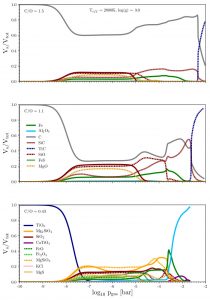
From our work we conclude: While it is almost impossible that pure carbon can condense in any oxygen-rich atmosphere based on an equilibrium gas-phase chemistry composition, carbon and carbonaceous material appears in abundance if C/O>1. It might therefore be thinkable that either i) the atmosphere of the giant exoplanet WASP-12b is indeed carbon-rich as the detection of HCN and C2H2 would suggest, or ii) the original atmosphere was nearly carbon-rich and an inefficient cloud formation tipped it over in the carbon-rich regime (like in Fig. 9 in Helling et al. 2014, or iii) external irradiation (e.g cosmic rays) drives a strong ion-neutral chemistry which leads to the emergence of larger carbo-hydrate molecules (Rimmer et al. 2014).
VULCAN: an Open-Source, Validated Chemical Kinetics Python Code for Exoplanetary Atmospheres
S.-M. Tsai, J.R. Lyon, L. Grosheintz, P.B. Rimmer, D. Kitzmann, K. Heng, 2017, ApJS 228, 20
An open-source and validated chemical kinetics code for studying hot exoplanetary atmospheres is presented (VULCAN). It is constructed for gaseous chemistry from 500 to 2500 K using a reduced C- H-O chemical network with about 300 reactions. It uses eddy diffusion to mimic atmospheric dynamics and excludes photochemistry. We have provided a full description of the rate coefficients and thermodynamic data used. VULCAN is validated by reproducing chemical equilibrium and by comparing its output versus the disequilibrium-chemistry calculations of Moses et al. and Rimmer & Helling.
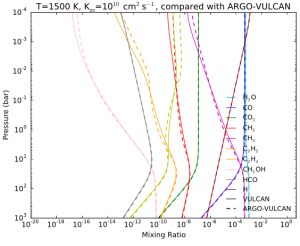
It reproduces the models of HD 189733b and HD 209458b by Moses et al., which employ a network with nearly 1600 reactions. Further validation of VULCAN is made by examining the theoretical trends produced when the temperature-pressure profile and carbon-to-oxygen ratio are varied. Assisted by a sensitivity test designed to identify the key reactions responsible for producing a specific molecule, we revisit the quenching approximation and find that it is accurate for methane but breaks down for acetylene, because the disequilibrium abundance of acetylene is not directly determined by transport-induced quenching, but is rather indirectly controlled by the disequilibrium abundance of methane. Therefore, we suggest that the quenching approximation should be used with caution and must always be checked against a chemical kinetics calculation. A one-dimensional model atmosphere with 100 layers, computed using VULCAN, typically takes several minutes to complete. VULCAN is written in Python and is publicly available as part of the Exoclimes Simulation Platform (ESP).
Dynamic mineral clouds on HD 189733b I. 3D RHD with kinetic, non-equilibrium cloud formation
G. Lee, I. Dobbs-Dixon, Ch. Helling, K. Bognar, P. Woitke, 2016, A&A 594, A48
3D modelling of cloud formation in atmospheres of extrasolar planets coupled to the atmospheric radiative, hydrodynamic and thermo-chemical properties has long been an open challenge. We present a 3D radiative-hydrodynamic (RHD) atmosphere model of HD 189733b fully coupled to a kinetic, microphysical mineral cloud formation model. We include the feedback effects of cloud advection and settling, gas phase element advection and depletion/replenishment and include the radiative effects of cloud and gas opacity. The 3D Navier-Stokes equations are solved consistently with a two-stream radiative transfer scheme coupled with the cloud moment conservation equations. We model the cloud particles as a mix of mineral materials which change in size and composition as they travel through atmospheric thermo-chemical environments.

The local cloud properties such as number density, grain size and material composition are time-dependently calculated. Gas phase element depletion as a result of cloud formation are calculated and uncondensed elements are advected across the globe. Mean cloud particle sizes are typically sub-micron (0.01-0.5 mum) at pressures less than 1 bar with hotter equatorial regions containing the smallest grains. Denser cloud structures occur near terminator regions and deeper (~1 bar) atmospheric layers. A thick, greyer opaque cloud layer is found to be at 100 mbar – 10 bar which contains micron sized or larger cloud particles. The cloud material composition differs across the globe, with various minerals dominating dependent on local thermo-chemical conditions. Silicate materials such as MgSiO3[s] are found to be abundant at mid-high latitudes. Elements involved in the cloud formation can be depleted by several orders of magnitude, with the exception of Oxygen which is depleted by a maximum of 30%.
Lightning climatology of exoplanets and brown dwarfs guided by Solar System data
G. Hodosan, Ch. Helling, R. Assensio-Torres, I. Vorgul, P.B. Rimmer, 2016, MNRAS 461, 3927
Clouds form on extrasolar planets and brown dwarfs where lightning could occur. Lightning is a tracer of atmospheric convection, cloud formation and ionization processes, and may be significant for the formation of prebiotic molecules.

Earth (WWLLN, Dec 2013; top), and optical energy distribution of Jovian and Saturnian flashes (bottom). No difference is made between intra-cloud and cloud-ground lightning.
We study lightning climatology for the different atmospheric environments of Earth, Venus, Jupiter and Saturn. We present lightning distribution maps for Earth, Jupiter and Saturn, and flash densities for these planets and Venus, based on optical and/or radio measurements from the WWLLN and STARNET radio networks, the LIS/OTD satellite instruments, the Galileo, Cassini, New Horizons and Venus Express spacecraft. We also present flash densities calculated for several phases of two volcano eruptions, Eyjafjallajokull’s (2010) and Mt Redoubt’s (2009). We estimate lightning rates for transiting and directly imaged extrasolar planets and brown dwarfs. Based on the large variety of exoplanets, six categories are suggested for which we use the lightning occurrence information from the Solar System. We examine lightning energy distributions for Earth, Jupiter and Saturn. We discuss how strong stellar activity may support lightning activity. We provide a lower limit of the total number of flashes that might occur on transiting planets during their full transit as input for future studies. We find that volcanically very active planets might show the largest lightning flash densities. When applying flash densities of the large Saturnian storm from 2010/11, we find that the exoplanet HD 189733b would produce high lightning occurrence even during its short transit.
see also LEAP Blog for the world 15 July 2016
Is lightning a possible source of the radio emission on HAT-P-11b?
G. Hodosan, P.B. Rimmer, Ch. Helling, 2016, MNRAS 461, 1222
Lightning induced radio emission has been observed on Solar system planets. There have been many attempts to observe exoplanets in the radio wavelength, however, no unequivocal detection has been reported. Lecavelier des Etangs et al. carried out radio transit observations of the exoplanet HAT-P-11b, and suggested that a small part of the radio flux can be attributed to the planet.
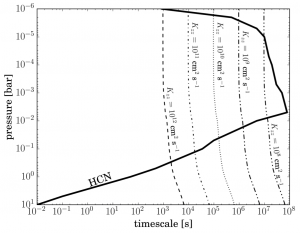
Here, we assume that this signal is real, and study if this radio emission could be caused by lightning with similar energetic properties like in the Solar system. We find that a lightning storm with 3.8 x 106 times larger flash densities than the Earth-storms with the largest lightning activity is needed to produce the observed signal from HAT-P-11b. The optical emission of such thunderstorm would be comparable to that of the host star. We show that HCN produced by lightning chemistry is observable 2-3 yr after the storm, which produces signatures in the L (3.0-4.0 \mu m) and N (7.5-14.5 \mu m) infrared bands. We conclude that it is unlikely that the observed radio signal was produced by lightning, however, future, combined radio and infrared observations may lead to lightning detection on planets outside the Solar system.
Direct Imaging discovery of a second planet candidate around the possibly transiting planet host CVSO 30
T. Schmidt, R. Neuhäuser, C. Briceño et al., 2016, A&A 593, 75
Direct imaging has developed into a very successful technique for the detection of exoplanets in wide orbits, especially around young stars. Directly imaged planets can be both followed astrometrically on their orbits and observed spectroscopically and thus provide an essential tool for our understanding of the early solar system.
We surveyed the 25 Ori association for direct-imaging companions. This association has an age of only few million years. Among other targets, we observed CVSO 30, which has recently been identified as the first T Tauri star found to host a transiting planet candidate.
We report on photometric and spectroscopic high-contrast observations with the Very Large Telescope, the Keck telescopes, and the Calar Alto observatory. They reveal a directly imaged planet candidate close to the young M3 star CVSO 30.
The JHK-band photometry of the newly identified candidate is at better than 1σ consistent with late-type giants, early-T and early-M dwarfs, and free-floating planets. Other hypotheses such as galaxies can be excluded at more than 3.5σ. A lucky imaging z’ photometric detection limit z’ = 20.5 mag excludes early-M dwarfs and results in less than 10 MJup for CVSO 30 c if bound. We present spectroscopic observations of the wide companion that imply that the only remaining explanation for the object is that it is the first very young (<10 Myr) L – T-type planet bound to a star, meaning that it appears bluer than expected as a result of a decreasing cloud opacity at low effective temperatures. Only a planetary spectral model is consistent with the spectroscopy, and we deduce a best-fit mass of 4-5 Jupiter masses (total range 0.6-10.2 Jupiter masses).
This means that CVSO 30 is the first system in which both a close-in and a wide planet candidate are found to have a common host star. The orbits of the two possible planets could not be more different: they have orbital periods of 10.76 h and about 27 000 yr. The two orbits may have formed during a mutual catastrophic event of planet-planet scattering.
Ionisation and discharge in cloud-forming atmospheres of brown dwarfs and extrasolar planets
Brown dwarfs and giant gas extrasolar planets have cold atmospheres with a rich chemical compositions from which mineral cloud particles form. Their particle sizes and material composition vary with height, and the mineral cloud particles are charged due to triboelectric processes in such dynamic atmospheres. The dynamics of the atmospheric gas is driven by the irradiating host star and/or by the rotation of the objects that changes during its lifetime. Thermal gas ionisation in these ultra-cool but dense atmospheres allows electrostatic interactions and magnetic coupling of a substantial atmosphere volume. Combined with a strong magnetic field >> B_Earth, a chromosphere and aurorae might form as suggested by radio and X-ray observations of brown dwarfs. Non-equilibrium processes like cosmic ray ionisation and discharge processes in clouds will increase the local pool of free electrons in the gas. Cosmic rays and lighting discharges also alter the composition of the local atmospheric gas such that tracer molecules might be identified. Cosmic rays affect the atmosphere through air showers which was modelled with a 3D Monte Carlo radiative transfer code to be able to visualise their spacial extent (see figure).
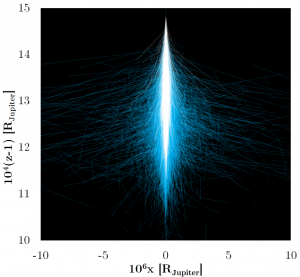
Given a certain degree of thermal ionisation of the atmospheric gas, we suggest that electron attachment to charge mineral cloud particles is too inefficient to cause an electrostatic disruption of the cloud particles. Cloud particles will therefore not be destroyed by Coulomb explosion for the local temperature in the collisional dominated brown dwarf and giant gas planet atmospheres. However, the cloud particles are destroyed electrostatically in regions with strong gas ionisation. The potential size of such cloud holes would, however, be too small and might occur too far inside the cloud to mimic the effect of, e.g., magnetic field induced star spots.
The mineral clouds on HD 209458b and HD189733b
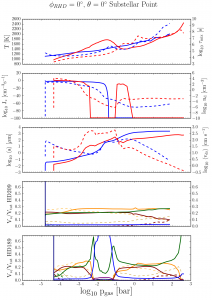
3D atmosphere model results are used to comparatively study the kinetic, non-equilibrium cloud formation in the atmospheres of two example planets guided by the giant gas planets HD209458b and HD189733b. Rather independently of hydrodynamic model differences, our cloud modelling suggests that both planets are covered in mineral clouds throughout the entire modelling domain. Both planets harbour chemically complex clouds that are made of mineral particles that have a height-dependent material composition and size. The remaining gas-phase element abundances strongly effects the molecular abundances of the atmosphere in the cloud forming regions. Hydrocarbon and cyanopolyyne molecules can be rather abundant in the inner, dense part of the atmospheres of HD189733b and HD209458b. No one value for metallicity and the C/O ratio can be used to describe an extrasolar planet. Our results concerning the presence and location of water in relation to the clouds explain some of the observed differences between the two planets. In HD189733b, strong water features have been reported while such features appear less strong for HD209458b. By considering the location of the clouds in the two atmospheres, we see that obscuring clouds exist high in the atmosphere of HD209458b, but much deeper in HD189733b. We further conclude that the (self-imposed) degeneracy of cloud parameters in retrieval methods can only be lifted if the cloud formation processes are accurately modelled in contrast to prescribing them by independent parameters.
see also LEAP Blog for the world 4 May 2016
Flash ionisation signature in coherent cyclotron emission from Brown Dwarfs
I. Vorgul & Ch. Helling; 2016, MNRAS 458, 1041
Brown dwarfs form mineral clouds in their atmospheres, where charged particles can produce large-scale discharges in form of lightning resulting in substantial sudden increase of local ionisation.
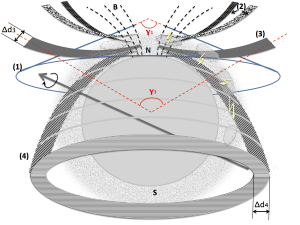
Brown dwarfs are observed to emit cyclotron radio emission. We show that signatures of strong transient atmospheric ionisation events (flash ionisation) can be imprinted on a pre-existing radiation. Detection of such flash ionisation events will open investigations into the ionisation state and atmospheric dynamics. Such events can also result from explosion shock waves, material outbursts or (volcanic) eruptions. We present an analytical model that describes the modulation of a pre-existing electromagnetic radiation by a time-dependent (flash) conductivity that is characteristic for flash ionisation events like lightning. Our conductivity model reproduces the conductivity function derived from observations of Terrestrial Gamma Ray Flashes, and is applicable to astrophysical objects with strong temporal variations in the local ionization, as in planetary atmospheres and protoplanetary disks. We show that the field responds with a characteristic flash-shaped pulse to a conductivity flash of intermediate intensity. More powerful ionisation events result in smaller variations of the initial radiation, or in its damping. We show that the characteristic damping of the response field for high-power initial radiation carries information about the ionisation flash magnitude and duration. The duration of the pulse amplification or the damping is consistently shorter for larger conductivity variations and can be used to evaluate the intensity of the flash ionisation. Our work suggests that cyclotron emission could be probe signals for electrification processes inside BD atmosphere.
Atmospheric electrification in dusty, reactive gases in the solar system and beyond
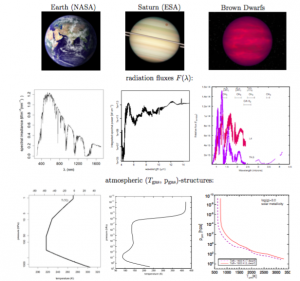
Detailed observations of the solar system planets reveal a wide variety of local atmospheric conditions. Astronomical observations have revealed a variety of extrasolar planets none of which resembles any of the solar system planets in full. Instead, the most massive amongst the extrasolar planets, the gas giants, appear very similar to the class of (young) Brown Dwarfs which are amongst the oldest objects in the universe. Despite of this diversity, solar system planets, extrasolar planets and Brown Dwarfs have broadly similar global temperatures between 300K and 2500K. In consequence, clouds of different chemical species form in their atmospheres. While the details of these clouds differ, the fundamental physical processes are the same. Further to this, all these objects were observed to produce radio and X-ray emission. While both kinds of radiation are well studied on Earth and to a lesser extent on the solar system planets, the occurrence of emission that potentially originate from accelerated electrons on Brown Dwarfs, extrasolar planets and protoplanetary disks is not well understood yet. This paper offers an interdisciplinary view on electrification processes and their feedback on their hosting environment in meteorology, volcanology, planetology and research on extrasolar planets and planet formation.
see also LEAP Blog for the world 15 Feb 2016
The First Millimeter Detection of a Non-Accreting Ultracool Dwarf
The well-studied M9 dwarf TVLM 513-46546 is a rapid rotator (P_rot ~ 2 hr) hosting a stable, dipolar magnetic field of ~3 kG surface strength. Here we report its detection with ALMA at 95 GHz at a mean flux density of $56 \pm 12$ uJy, making it the first ultracool dwarf detected in the millimeter band, excluding young, disk-bearing objects. We also report flux density measurements from unpublished archival VLA data and new optical monitoring data from the Liverpool Telescope.
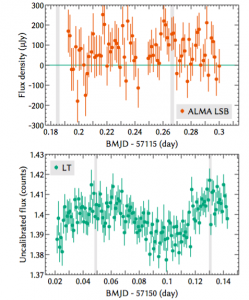
The ALMA data are consistent with a power-law radio spectrum that extends continuously between centimeter and millimeter wavelengths. We argue that the emission is due to the synchrotron process, excluding thermal, free-free, and electron cyclotron maser emission as possible sources. During the interval of the ALMA observation that phases with the maximum of the object’s optical variability, the flux density is higher at a ~1.8 sigma significance level. These early results show how ALMA opens a new window for studying the magnetic activity of ultracool dwarfs, particularly shedding light on the particle acceleration mechanism operating in their immediate surroundings.
A Chemical Kinetics Network for Lightning and Life in Planetary Atmospheres
P.R. Rimmer & Ch. Helling, 2016, ApJS 224, 9

There are many open questions about prebiotic chemistry in both planetary and exoplanetary environments. The increasing number of known exoplanets and other ultra-cool, substellar objects has propelled the desire to detect life and prebiotic chemistry outside the solar system. We present an ion-neutral chemical network constructed from scratch, Stand2015, that treats hydrogen, nitrogen, carbon and oxygen chemistry accurately within a temperature range between 100 K and 30000 K. Formation pathways for glycine and other organic molecules are included. The network is complete up to H6C2N2O3. Stand2015 is successfully tested against atmospheric chemistry models for HD209458b, Jupiter and the present-day Earth using a simple 1D photochemistry/diffusion code. Our results for the early Earth agree with those of Kasting (1993) for CO2, H2, CO and O2, but do not agree for water and atomic oxygen. We use the network to simulate an experiment where varied chemical initial conditions are irradiated by UV light. The result from our simulation is that more glycine is produced when more ammonia and methane is present. Very little glycine is produced in the absence of any molecular nitrogen and oxygen. This suggests that production of glycine is inhibited if a gas is too strongly reducing. Possible applications and limitations of the chemical kinetics network are also discussed.
see also LEAP Blog for the world 19 Jan 2016
Extended Baseline Photometry of Rapidly Changing Weather Patterns on the Brown Dwarf Binary Luhman-16
Luhman-16 (WISE J1049-5319) was recently discovered to be a nearby (∼2 pc) brown dwarf binary that exhibits a high degree of photometric variability (Δm ∼ 0.1 mag). This is thought to be due to the evolution of “cloud” features on the photosphere, but Luhman-16 has been found to show unusually rapid changes, possibly resulting from fast-evolving “weather.” This target is of particular interest because it consists of a co-evolutionary pair of brown dwarfs spanning the transition between L and T spectral types (L7.5 and T0.5), which are expected to be associated with changes in cloud surface coverage. Being comparatively bright (I ∼ 15.5 mag), the target is well suited for observation with the new Las Cumbres Observatory Global Telescope Network (LCOGT) of 1 m telescopes. We present long-time baseline photometric observations from two of LCOGT’s southern hemisphere sites, which were used in tandem to monitor Luhman-16 for up to 13.25 hr at a time (more than twice the rotation period), for a total of 41.2 days in the SDSS-i‧ and Pan-STARRS-Z filters. We use this data set to characterize the changing rotational modulation, which may be explained by the evolution of cloud features at varying latitudes on the surfaces of the two brown dwarfs.
Reference study to characterise plasma and magnetic properties of ultra-cool atmospheres
M.I. Rodríguez-Barrera, Ch. Helling, C.R. Stark, A.M. Rice, 2015, MNRAS 454, 3977
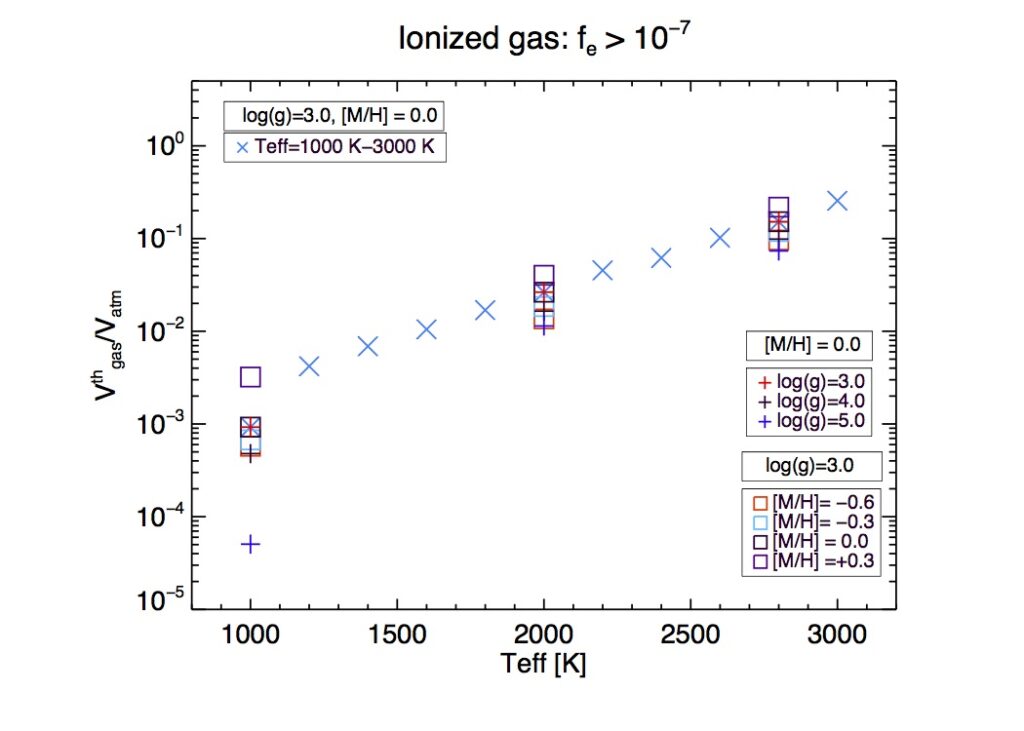
Radio and X-ray emission from brown dwarfs suggest that an ionised gas and a magnetic field with a sufficient flux density must be present. We perform a reference study for late M-dwarfs, brown dwarfs and giant gas planet to identify which ultra-cool objects are most susceptible to plasma and magnetic processes. Only thermal ionisation is considered. We utilise the Drift-Phoenix model grid where the local atmospheric structure is determined by the global parameters Teff, log(g) and [M/H].
Our results show that it is not unreasonable to expect Hα or radio emission to origin from Brown Dwarf atmospheres as in particular the rarefied upper parts of the atmospheres can be magnetically coupled despite having low degrees of thermal gas ionisation. Such ultra-cool atmospheres could therefore drive auroral emission without the need for a companion’s wind or an outgassing moon. The minimum threshold for the magnetic flux density required for electrons and ions to be magnetised is well above typical values of the global magnetic field of a brown dwarf and a giant gas planet. Na+, K+ and Ca+ are the dominating electron donors in low-density atmospheres (low log(g), solar metallicity) independent of Teff. Mg+ and Fe+ dominate the thermal ionisation in the inner parts of M-dwarf atmospheres. Molecules remain unimportant for thermal ionisation. Chemical processes (e.g. cloud formation) affecting the most abundant electron donors, Mg and Fe, will have a direct impact on the state of ionisation in ultra-cool atmospheres.
see also LEAP Blog for the world 10 Nov 2015
Modelling the local and global cloud formation on HD 189733b
G. Lee, Ch. Helling, I. Dobbs-Dixon, D. Juncher, 2015, A&A 580, A12
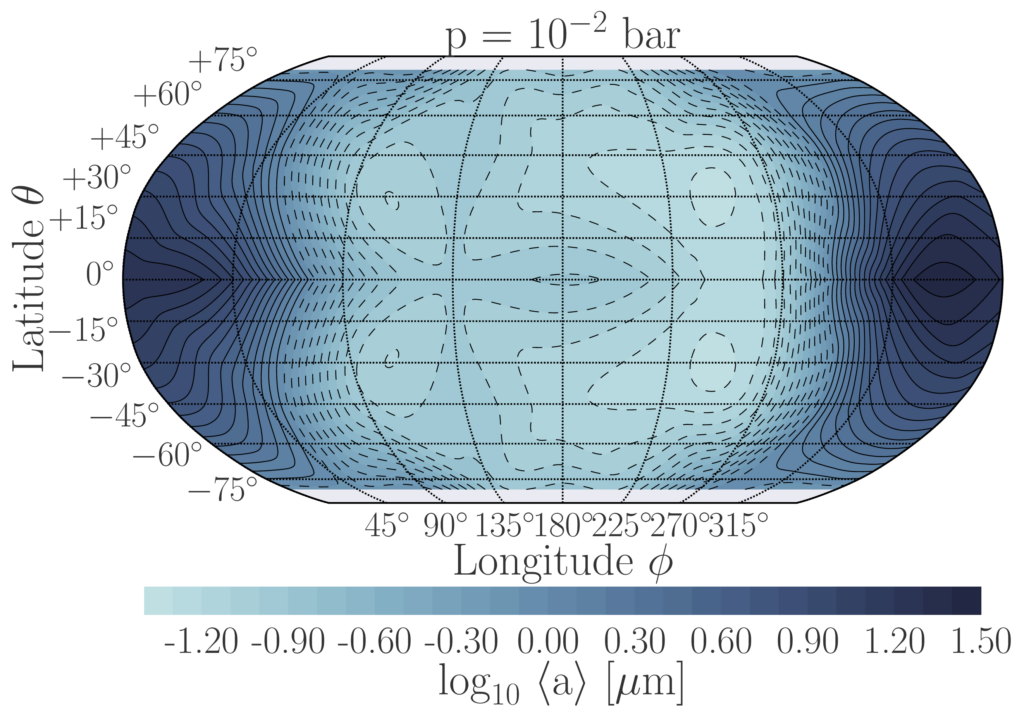
Context. Observations suggest that exoplanets such as HD 189733b form clouds in their atmospheres which have a strong feedback onto their thermodynamical and chemical structure, and overall appearance. Aims. Inspired by mineral cloud modelling efforts for Brown Dwarf atmospheres, we present the first spatially varying kinetic cloud model structures for HD 189733b. Methods. We apply a 2-model approach using results from a 3D global radiation-hydrodynamic simulation of the atmosphere as input for a detailed, kinetic cloud formation model. Sampling the 3D global atmosphere structure with 1D trajectories allows us to model the spatially varying cloud structure on HD 189733b. The resulting cloud properties enable the calculation of the scattering and absorption properties of the clouds. Results. We present local and global cloud structure and property maps for HD 189733b. The calculated cloud properties show variations in composition, size and number density of cloud particles which are strongest between the dayside and nightside. Cloud particles are mainly composed of a mix of materials with silicates being the main component. Cloud properties, and hence the local gas composition, change dramatically where temperature inversions occur locally. The cloud opacity is dominated by absorption in the upper atmosphere and scattering at higher pressures in the model. The calculated 8 μm single scattering Albedo of the cloud particles are consistent with Spitzer bright regions. The cloud particles scattering properties suggest that they would sparkle/reflect a midnight blue colour at optical wavelengths.
see also LEAP Blog for the world 29 May 2015
Inhomogeneous cloud coverage through the Coulomb explosion of dust in substellar atmospheres
C.R. Stark, Ch. Helling, D.A. Diver, 2015, A&A 579
Recent observations of brown dwarf spectroscopic variability in the infrared infer the presence of patchy cloud cover. This paper proposes a mechanism for producing inhomogeneous cloud coverage due to the depletion of cloud particles through the Coulomb explosion of dust in atmospheric plasma regions. Charged dust grains Coulomb-explode when the electrostatic stress of the grain exceeds its mechanical tensile stress. As a result, the dust population is depleted, and the cloud opacity become optically thin in the wavelength range 0.1-10 μm.
Multiwaveband photometry of the irradiated brown dwarf WD0137-349B
WD0137-349 is a white dwarf-brown dwarf binary system in a 116 minute orbit. We present radial velocity observations and multiwaveband photometry from V, R and I in the optical, to J, H and Ks in the near-IR and 3.6, 4.5, 5.8 and 8.0 μm in the mid-IR. The photometry and lightcurves show variability in all wavebands, with the amplitude peaking at 4.5 μm, where the system is also brightest. Fluxes and brightness temperatures were computed for the heated and unheated atmosphere of the brown dwarf (WD0137-349B) using synthetic spectra of the white dwarf using model atmosphere simulations. We show that the flux from the brown dwarf dayside is brighter than expected in the Ks and 4.5 μm bands when compared to models of irradiated brown dwarfs with full energy circulation and suggest this over-luminosity may be attributed to H2 fluorescence or H3+ being generated in the atmosphere by the UV irradiation.
see also LEAP Blog for the world 16 Feb 2015
Dust in brown dwarfs and extra-solar planets IV. Assessing TiO2 and SiO nucleation for cloud formation modeling
G. Lee, Ch. Helling, H. Giles, S. T. Bromley, 2015, A&A 575
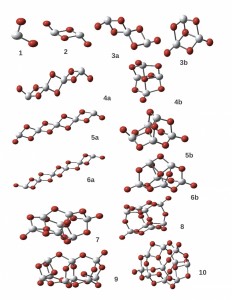
Clouds form in atmospheres of brown dwarfs and planets. The cloud particle
formation processes are similar to the dust formation process studied in circumstellar shells of AGB stars and in Supernovae. We re-address the question of the primary nucleation species in view of new (TiO2)N-cluster data and new SiO vapour pressure data. We apply the density functional theory using the computational chemistry package Gaussian 09 to derive updated thermodynamical data for (TiO2)N-clusters as input for our TiO2 seed formation model. We test different nucleation treatments and their effect on the overall cloud structure by solving a system of dust moment equations and element conservation or a prescribed Drift-Phoenix atmosphere structure. Updated Gibbs free energies for the (TiO2)N-clusters are presented, and a slightly temperature dependent surface tension for T=500 … 2000K with an average value of σ∞ = 480.6 erg cm-2. The TiO2-seed formation rate changes only slightly with the updated cluster data. A considerably larger effect on the rate of seed formation, and hence on grain size and dust number density, results from a switch to SiO-nucleation. Despite the higher abundance of SiO over TiO2 in the gas phase, TiO2 remains considerably more efficient in forming condensation seeds by homogeneous nucleation followed by heterogeneous grain growth. The paper discusses also the effect on the cloud structure.
see also LEAP Blog for the world 20 Jan 2015
Atmospheres of Brown Dwarfs
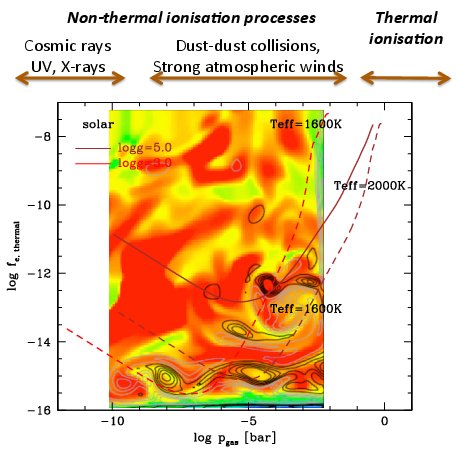
Brown Dwarfs are the coolest class of stellar objects known to date. Our present perception is that Brown Dwarfs follow the principles of star formation, and that Brown Dwarfs share many characteristics with planets. Being the darkest and lowest mass stars known makes Brown Dwarfs also the coolest stars known. This has profound implication for their spectral fingerprints. Brown Dwarfs cover a range of effective temperatures which cause brown dwarfs atmospheres to be a sequence that gradually changes from a M-dwarf-like spectrum into a planet-like spectrum. This further implies that below an effective temperature of < 2800K, clouds form already in atmospheres of objects marking the boundary between M-Dwarfs and brown dwarfs. Recent developments have sparked the interest in plasma processes in such very cool atmospheres: sporadic and quiescent radio emission has been observed in combination with decaying Xray-activity indicators across the fully convective boundary.
Jupiter as a Giant Cosmic Ray Detector
P.B. Rimmer, C.R. Stark, Ch. Helling, 2014, ApJ 787, 25
We explore the feasibility of using the atmosphere of Jupiter to detect ultra-high-energy cosmic rays (UHECRs). The large surface area of Jupiter allows us to probe cosmic rays of higher energies than previously accessible. Cosmic ray extensive air showers in Jupiter’s atmosphere could in principle be detected by the Large Area Telescope (LAT) on the Fermi observatory. In order to be observed, these air showers would need to be oriented toward the Earth, and would need to occur sufficiently high in the atmosphere that the gamma rays can penetrate. We demonstrate that, under these assumptions, Jupiter provides an effective cosmic ray “detector” area of 3.3 × 107 km2.
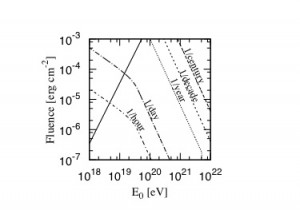
Cosmic ray frequency as a function of the energy of the extensive airshower, E0 [eV], and the gamma ray fluence [erg cm-2] as observed by Fermi-LAT. The solid line indicates the maximum fluence from an extensive air shower of energy E0. We predict that Fermi-LAT should be able to detect events of energy >1021 eV with fluence 10-7 erg cm-2 at a rate of about one per month. The observed number of air showers may provide an indirect measure of the flux of cosmic rays >~ 1020 eV. Extensive air showers also produce a synchrotron signature that may be measurable by Atacama Large Millimeter/submillimeter Array (ALMA). Simultaneous observations of Jupiter with ALMA and Fermi-LAT could be used to provide broad constraints on the energies of the initiating cosmic rays.
Disk evolution, element abundances and cloud properties of young gas giant planets
Ch. Helling, P. Woitke, P.B. Rimmer, I. Kamp, W.-F. Thi, R. Meijerink, 2014, Life 4, 142 We discuss the chemical pre-conditions for planet formation, in terms of gas and ice abundances in a protoplanetary disk, as function of time and position, and the resulting chemical composition and cloud properties in the atmosphere when young gas giant planets form. Large deviations between the abundances of the host star and its gas giants seem likely to occur if the planet formation follows the core-accretion scenario. ProDiMo protoplanetary disk models are used to predict the chemical evolution of gas and ice in the midplane. We find that cosmic rays play a crucial role in slowly un-blocking the CO, where the liberated oxygen forms water, which then freezes out quickly. Therefore, the C/O ratio in the gas phase is found to gradually increase with time, in a region bracketed by the water and CO ice-lines.
Carbon-to-oxygen ratio after cloud formation from an initial disk element abundance with C/Oinit=0.99. In this regions, C/O is found to approach unity after about 5 Myrs, scaling with the cosmic ray ionisation rate. We then explore how the atmospheric chemistry and cloud properties in young gas giants are affected when the non-solar C/O ratios predicted by the disk models are assumed. The DRIFT cloud formation model is applied to study the formation of atmospheric clouds under the influence of varying primordial element abundances and its feedback onto the local gas. We demonstrate that element depletion by cloud formation plays a crucial role in converting an oxygen-rich atmosphere gas into carbon-rich gas when non-solar, primordial element abundances are considered as suggested by disk model.
Ionisation in atmospheres of brown dwarfs and extrasolar planets VI: Properties of large-scale discharge events
R. Bailey, Ch. Helling, G. Hodosan, C. Bilger, C. R. Stark, 2013, ApJ, 784, 43
Mineral clouds in substellar atmospheres play a special role as a catalyst for a variety of charge processes. If clouds are charged, the surrounding environment becomes electrically activated, and ensembles of charged grains are electrically discharging (e.g. by lightning), which significantly influences the local chemistry creating conditions similar to those thought responsible for life in early planetary atmospheres.
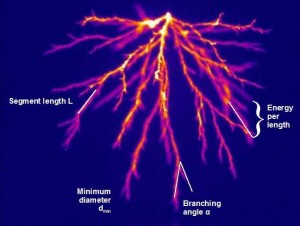
Laboratory streamer properties applied to substellar atmospheres. (Briels et al. 2008; IOP Publishing. Reproduced with permission. All rights reserved.)
We note that such lightning discharges contribute also to the ionisation state of the atmosphere. We apply scaling laws for electrical discharge processes from laboratory measurements and numerical experiments to Drift-Phoenix model atmosphere results to model the discharge’s propagation downwards (as lightning) and upwards (as sprites) through the atmospheric clouds. We evaluate the spatial extent and energetics of lightning discharges.
The atmospheric volume affected (e.g. by increase of temperature or electron number) is larger in a brown dwarf atmosphere than in a giant gas planet’s. Our results suggest that the total dissipated energy in one event is <10^12 J for all models of initial solar metallicity. First attempts to show the influence of lightning on the local gas phase indicate an increase of small carbohydrate molecules like CH and CH2 at the expense of CO and CH4. Dust forming molecules are destroyed and the cloud particle properties are frozen-in unless enough time is available for complete evaporation. We summerise instruments potentially suitable to observe lightning on extrasolar objects.
see also LEAP Blog for the world 30 April 2014
The Influence of Galactic Cosmic Rays on Ion-Neutral Hydrocarbon Chemistry in the Upper Atmospheres of Free-Floating Exoplanets
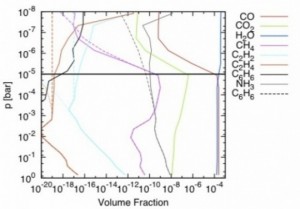
Paul B. Rimmer, Christiane Helling, Camille Bilger 2013, JAsB 13, 173 Volume fraction of various species as a function of the gas pressure for the model atmosphere of a free-floating giant gas planet.
Cosmic rays may be linked to the formation of volatiles necessary for prebiotic chemistry. We explore the effect of cosmic rays in a hydrogen-dominated atmosphere, as a proof-of-concept that ion-neutral chemistry may be important for modelling hydrogen-dominated atmospheres. In order to accomplish this, we utilize Monte Carlo cosmic ray transport models with particle energies of 10^6 eV < E < 10^12 eV in order to investigate the cosmic ray enhancement of free electrons in substellar atmospheres. Ion-neutral chemistry is then applied to a Drift-Phoenix model of a free-floating giant gas planet. Our results suggest that the activation of ion-neutral chemistry in the upper atmosphere significantly enhances formation rates for various species, and we find that C2H2, C2H4, NH3, C6H6 and possibly C10H are enhanced in the upper atmospheres because of cosmic rays. Our results suggest a potential connection between cosmic ray chemistry and the hazes observed in the upper atmospheres of various extrasolar planets. Chemi-ionization reactions are briefly discussed, as they may enhance the degree of ionization in the cloud layer.
see also LEAP Blog for the world 14 March 2014
Electrostatic activation of prebiotic chemistry in substellar atmospheres
Craig R. Stark, Christiane Helling, Declan A. Diver, Paul Rimmer 2013, IJAsB 13, 165

Most likely series of ion-neutral reactions that lead to the formation of glycine.
Charged dust grains in the atmospheres of exoplanets may play a key role in the formation of prebiotic molecules, necessary to the origin of life. Dust grains submerged in an atmospheric plasma become negatively charged and attract a flux of ions that are accelerated from the plasma. The energy of the ions upon reaching the grain surface may be sufficient to overcome the activation energy of particular chemical reactions that would be unattainable via ion and neutral bombardment from classical, thermal excitation. As a result, prebiotic molecules or their precursors could be synthesised on the surface of dust grains that form clouds in exoplanetary atmospheres. This paper investigates the energization of the plasma ions, and the dependence on the plasma electron temperature, in the atmospheres of substellar objects such as gas giant planets. Calculations show that modest electron temperatures of ~ 1eV (~10000 K) are enough to accelerate ions to sufficient energies that exceed the activation energies required for the formation of formaldehyde, ammonia, hydrogen cyanide and the amino acid glycine.
see also University press release , astrobits , universe today
see also LEAP Blog for the world 28 Jan 2014
Ionization in Atmospheres of Brown Dwarfs and Extrasolar Planets V: Alfven Ionization
Craig R. Stark, Christiane Helling, Declan A. Diver, Paul Rimmer 2013, ApJ 776, 11

Evolution of an electron overdensity due to its self-electrostatic field,in the presence of vertically oriented magnetic field. Similar effects can be expected for the Alfvén ionization process. Credit:MacLachlan et al. New J Phys.1, 063001, 2009
Observations of continuous radio and sporadic X-ray emission from low-mass objects suggest they harbour localized plasmas in their atmospheric environments. We propose Alfven ionization as a mechanism for producing localized pockets of ionized gas in the atmosphere, having sufficient degrees of ionization (>10^-7) that they constitute plasmas. We outline the criteria required for Alfven ionization to occur and demonstrate it’s applicability in the atmospheres of low-mass objects such as giant gas planets, brown dwarfs and M-dwarfs. Our results show that degrees of ionization ranging from 10^-6 … 1 can be obtained. Furthermore, Alfven ionization alters the atmospheric chemistry via the creation of new ionic species not normally available in contemporary, thermally-driven atmospheric models. Observable consequences include continuum Bremsstrahlung emission superimposed with spectral lines from the plasma ion species.
Small hydrocarbon molecules in cloud-forming Brown Dwarf and giant gas planet atmospheres
Camille Bilger, Paul Rimmer, Christiane Helling 2013, MNRAS 435, 1888
We study the abundances of complex carbon-bearing molecules in the oxygen-rich
dust- forming atmospheres of Brown Dwarfs and giant gas planets. Results from Drift-phoenix atmosphere simulations, which include the feedback of phase-non-equilibrium dust cloud formation on the atmospheric structure and the gas-phase abundances, are utilised. The resulting element depletion leads to a shift in the carbon-to-oxygen ratio such that several hydrocarbon molecules and cyanopolyynene molecules can be present.
We determine chemical relaxation time-scales to evaluate if hydrocarbon molecules can be affected by transport-induced quenching. Our results suggest that a considerable amount of C2H6 and C2H2 could be expected in the upper atmospheres not only of giant gas planets, but also of Brown Dwarfs. However, the exact quenching height strongly depends on the data source used. These results will have an impact on future thermo-kinetic studies, as they change the inner boundary condition for those simulations.
Ionization in atmospheres of Brown Dwarfs and extrasolar planets IV. The Effect of Cosmic Rays
Paul Rimmer and Christiane Helling 2013, ApJ 774, 108
Cosmic rays provide an important source for free electrons in the Earth’s atmosphere and also in dense interstellar regions where they produce a prevailing background ionization. We utilize a Monte Carlo cosmic ray transport model for particle energies of 1 MeV < E < 1 GeV, and an analytic cosmic ray transport model for particle energies of 1 GeV < E < 1 TeV in order to investigate the cosmic ray enhancement of free electrons in substellar atmospheres of free-floating objects. For the model brown dwarf atmosphere, the electron fraction is enhanced significantly by cosmic rays when the pressure pgas < 10^-2 bar. Our example giant gas planet atmosphere suggests that the cosmic ray enhancement extends to 10^-4 – 10^-2 bar, depending on the effective temperature. For the model atmosphere of the example giant gas planet considered here (Teff = 1000 K), cosmic rays bring the degree of ionization to fe ~ 10^-8 when pgas < 10^-8 bar, suggesting that this part of the atmosphere may behave as a weakly ionized plasma. Although cosmic rays enhance the degree of ionization by over three orders of magnitude in the upper atmosphere, the effect is not likely to be significant enough for sustained coupling of the magnetic field to the gas.
Ionisation in atmospheres of Brown Dwarfs and extrasolar planets III. Breakdown conditions for mineral clouds
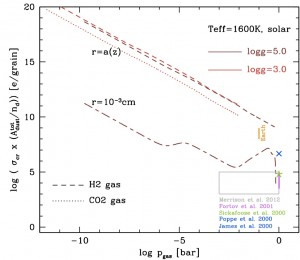
Christiane Helling, Moira Jardine, Craig Stark, Declan Diver 2013, ApJ 767, 136 Critical number of charges per dust grain [e/grain] needed for electric breakdown in mineral clouds inside atmospheres for objects with Teff =1600K and log(g)=3.0 (red) and log(g)=5.0 (brown).
Electric discharges were detected directly in the cloudy atmospheres of Earth, Jupiter and Saturn, are debatable for Venus, and indirectly inferred for Neptune and Uranus in our solar system. Sprites (and other types of transient luminous events) have been detected only on Earth, and are theoretically predicted for Jupiter, Saturn and Venus.
Cloud formation is a common phenomenon in ultra-cool atmospheres such as in Brown Dwarf and extrasolar planetary atmospheres. We investigate electrostatic breakdown characteristics, like critical field strengths and critical charge densities per surface, to demonstrate under which conditions mineral clouds undergo electric discharge events which may trigger or be responsible for sporadic X-ray emission.
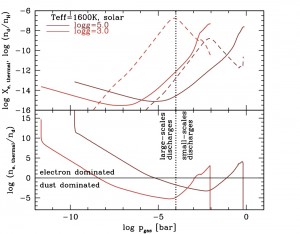
Top : Degree of thermal gas ionisation (solid lines) and the dust number density per hydrogen (dashed lines). Bottom: The The efficiency with which a streamer may be initiated in a mineral cloud.
We apply results from our kinetic dust cloud formation model that is part of the Drift-Phoenix model atmosphere simulations. We present a first investigation of the dependence of the breakdown conditions in Brown Dwarf and giant gas exoplanets on the local gas-phase chemistry, the effective temperature and primordial gas-phase metallicity. Our results suggest that different intra-cloud discharge processes dominate at different heights inside mineral clouds: local coronal (point discharges) and small-scale sparks at the bottom region of the cloud where the gas density is high, and flow discharges and large-scale sparks near, and maybe above, the cloud top. The comparison of the thermal degree of ionisation and the number density of cloud particles allows us to suggest the efficiency with which discharges will occur in planetary atmospheres.
Energetic Charged Particles Above Thunderclouds
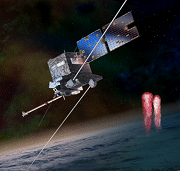
The French government has committed to launch the satellite TARANIS to study transient coupling processes between the Earth’s atmosphere and near-Earth space. The prime objective of TARANIS is to detect energetic charged particles and hard radiation emanating from thunderclouds. The British Nobel prize winner C.T.R. Wilson predicted lightning discharges from the top of thunderclouds into space almost a century ago. However, new experiments have only recently confirmed energetic discharge processes which transfer energy from the top of thunderclouds into the upper atmosphere and near-Earth space; they are now denoted as transient luminous events, terrestrial gamma-ray flashes and relativistic electron beams. This meeting report builds on the current state of scientific knowledge on the physics of plasmas in the laboratory and naturally occurring plasmas in the Earth’s atmosphere to propose areas of future research. The report specifically reflects presentations delivered by the members of a novel Franco-British collaboration during a meeting at the French Embassy in London held in November 2011. The scientific subjects of the report tackle ionization processes leading to electrical discharge processes, observations of transient luminous events, electromagnetic emissions, energetic charged particles and their impact on the Earth’s atmosphere. The importance of future research in this area for science and society, and towards spacecraft protection, is emphasized.
Clouds in brown dwarfs and giant planets
A growing body of observational and theoretical evidence points toward the importance of clouds in the atmospheres of ultra-cool brown dwarfs and giant planets. Empirically, the presence of clouds is inferred from the red, likely dusty atmospheres of young substellar objects, and from detections of periodic variability in a fraction of brown dwarfs – as expected from rotation and a patchy cloud cover. Theoretical models have progressed alongside by including ever more comprehensive atomic and molecular opacity tables, incorporating the treatment of non-equilibrium chemistry and clouds through vertical mixing and grain size/sedimentation parameters, and employing 3-D hydrodynamical simulations. In this proceeding we summarize the key issues raised during the first gathering of observers and theorists to discuss clouds and atmospheric circulation in non-irradiated ultra-cool dwarfs and giant planets.
M dwarf stars in the light of (future) exoplanet searches
We present a brief overview of a splinter session on M dwarf stars as planet hosts that was organized as part of the Cool Stars 17 conference. The session was devoted to reviewing our current knowledge of M dwarf stars and exoplanets in order to prepare for current and future exoplanet searches focusing in low mass stars. We review the observational and theoretical challenges to characterize M dwarf stars and the importance of accurate fundamental parameters for the proper characterization of their exoplanets and our understanding on planet formation.
Dust cloud lightning in extraterrestrial atmospheres
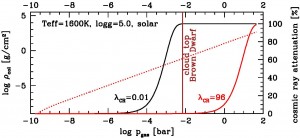
Helling Ch., Jardine M., Diver D., Witte S, (2013, P&SS, 77, 152) Cosmic ray attenuation (in %; solid lines, right axis) and gas-phase column density ρcol (in g/cm2; dotted lines, left axis)
Lightning is present in all solar system planets which form clouds in their atmospheres. Cloud formation outside our solar system is possible in objects with much higher temperatures than on Earth or on Jupiter: Brown dwarfs and giant extrasolar gas planets form clouds made of mixed materials and a large spectrum of grain sizes. These clouds are globally neutral but we argue that mineral clouds in brown dwarfs and extrasolar planets are susceptible to local discharge events and that the upper cloud layers are most suitable for powerful lightning-like discharges. We discuss various sources of atmospheric ionisation, including thermal ionisation and a first estimate of ionisation by cosmic rays, and argue that we should expect thunderstorms also in the atmospheres of brown dwarfs and giant gas planets which contain mineral clouds.
Ionisation in atmospheres of Brown Dwarfs and extrasolar planets II Dust-induced collisional ionization
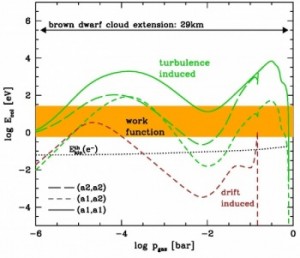
Helling Ch., Jardine M., Mokler F. (2011, ApJ 532) Turbulent dust-dust collisional energies compared to the ionisation energy of mixed grain materials
Observations have shown that continuous radio emission and also sporadic H-alpha and X-ray emission are prominent in singular, low-mass objects later than spectral class M. These activity signatures are interpreted as being caused by coupling of an ionised atmosphere to the stellar magnetic field. In Brown Dwarfs, thermal gas processes are insufficient, but the formation of clouds sets in. Cloud particles can act as seeds for electron avalanches in streamers that ionise the ambient gas, and can lead to lightning and indirectly to magnetic field coupling, a combination of processes also expected for protoplanetary disks. Time-scale comparison suggest lightning regime in upper part of brown dwarf atmospheric clouds
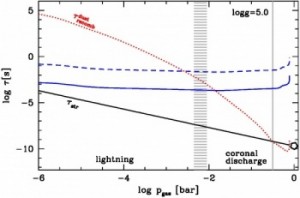
However, the precondition is that the cloud particles are charged. We use results from Drift-Phoenix model atmospheres to investigate collisional processes. We show that ionisation by turbulence-induced dust-dust collisions is the most efficient kinetic process. Dust-dust collisions alone are not sufficient to improve the magnetic coupling of the atmosphere inside the cloud layers, but the charges supplied either on grains or within the gas phase as separated electrons can trigger secondary non-linear processes. We suggest that although thermal gas ionisation declines in objects across the fully-convective boundary, dust charging by collisional processes can play an important role in the lowest mass objects. The onset of atmospheric dust may therefore correlate with the anomalous X-ray and radio emission in atmospheres that are cool, but charged more than expected by pure thermal ionisation.
The influence of non-isotropic scattering of thermal emission on spectra of brown dwarfs and hot exoplanets.
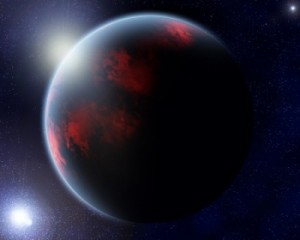
de Kok, Helling, Stam, Woitke and Witte (2011, A&A 531, 67)
We calculate near-infrared thermal emission spectra, which includes scattering by clouds and haze. Initial temperature profiles and cloud optical depths are taken from the DRIFT-PHOENIX Brown Dwarf model.
We show that cloud particles tend to reduce fluxes in the near-infrared spectrum and make it more red compared to the clear sky case. This is especially apparent for particles that are large compared to the wavelength and have only little iron in them. Scattering particles will show deeper absorption features than absorbing (e.g. iron) particles and scattering and particle size will also affect the calculated infrared colours. Large particles tend to be strongly forward-scattering and we show that assuming isotropic scattering in this case also leads to very large errors in the spectrum. The fact that the thermal radiation can be scattered also means that it can be polarised.
It is interesting to note that the small dark particles predicted by DRIFT-PHOENIX will also result in a lower geometric albedo of the planet at visible wavelengths compared to Rayleigh scattering or relatively large enstatite particles. Because the small iron-rich particles are dark, this haze may contribute to the low albedos of some hot Jupiters. The darkening effect of small iron particles has already been noted in earlier works, but the DRIFT-PHOENIX model might provide a physical basis for this argument.
The role of electron avalanche processes in atmospheres of Brown Dwarfs.
Helling, Jardine, Witte and Diver (2011, ApJ 727)

Brown dwarf and extrasolar planet atmospheres form clouds which strongly influence the local chemistry and physics. These clouds are globally neutral obeying dust-gas charge equilibrium which is, on short timescales, inconsistent with the observation of stochastic ionization events of the solar system planets. We argue that a significant volume of the clouds in brown dwarfs and extrasolar planets is susceptible to local discharge events. These are electron avalanches triggered by charged dust grains. Such intra-cloud discharges occur on timescales shorter than the time needed to neutralize the dust grains by collisional processes. An ensemble of discharges is likely to produce enough free charges to suggest a partial and stochastic coupling of the atmosphere to a large-scale magnetic field.

